E RAE Electronics Industry Co EPT-423BKA PDP Monitor User Manual 90 X 42 X3NM BDMI 00
E-RAE Electronics Industry Co Ltd PDP Monitor 90 X 42 X3NM BDMI 00
Users Manual
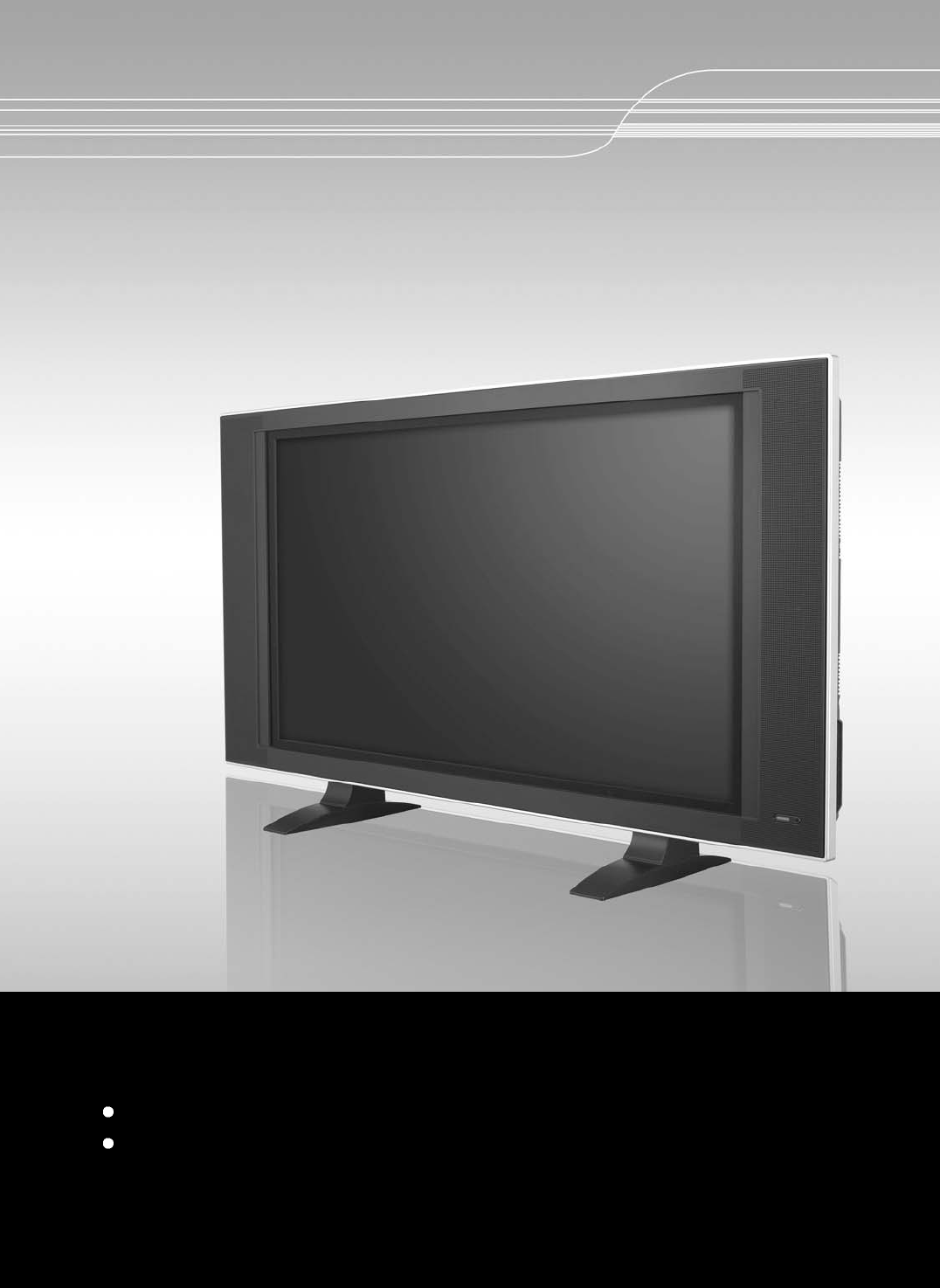
42˝ PDP Monitor User's Guide
Please observe all safety precautions when using this product.
Please read this manual carefully before using this product.

2
CONTENTS
Quick and Easy Installation That doesn’t make you feel fatigue on your Eyes.
Versatility and Expandability Flat-Panel Digital Display easy on the Eyes.
Safety Precautions
Power Supply 4
Installation 5
Use and Maintenance 6
Important Safety Instructions 7~9
Considerations for usage 10
User Guidance Information
Name of each part 11
Controls and Functions 12
Accessories 12
Mounting on a wall 13
Installation Precautions 13
Remote controller 14
Precautions 15
Connections
VCR Connections 16
Cable TV Connections 17~18
Camcorder/ Game Console Connections 19
DVD Connections 20~21
DTV Connections 22
PC Connections 23
Home Theater Connections 24
Stereo Out Connections 24
Basic Use
Powering the PDP Monitor 25
Initial Settings 25
Watching TV 26
Selecting TV/ External Input 27
Using the Menu 27
To Set Location 28
Changing Picture Settings 29

3
CONTENTS
Basic Use
Changing Sound Settings 30
Custom Sound Adjustment 31
Selecting the Menu Language 32
Setting OSD Tone Menu Background 33
Application
Changing Screen Size 33
To view the still picture 33
Viewing Picture in Picture 34~35
Auto Volume Control 36
Stereo Setting 36
Resetting PDP Monitor Setting 37
Setting Time 38
Automatic Power On/ Off 39
Monitor
Using TV as a Moniter 40
Adjusting PC Screen 40
Adjusting Colour Tone 41
External adjustment
Extermal adjustment 42
Set ID 42
Special features 43
RS-232C Communication Protocol 44~47
Maintenance and Service
Trouble shooting 48
Trouble shooting Tips 49
Supported Display Modes 49~50
42" Specifications 51
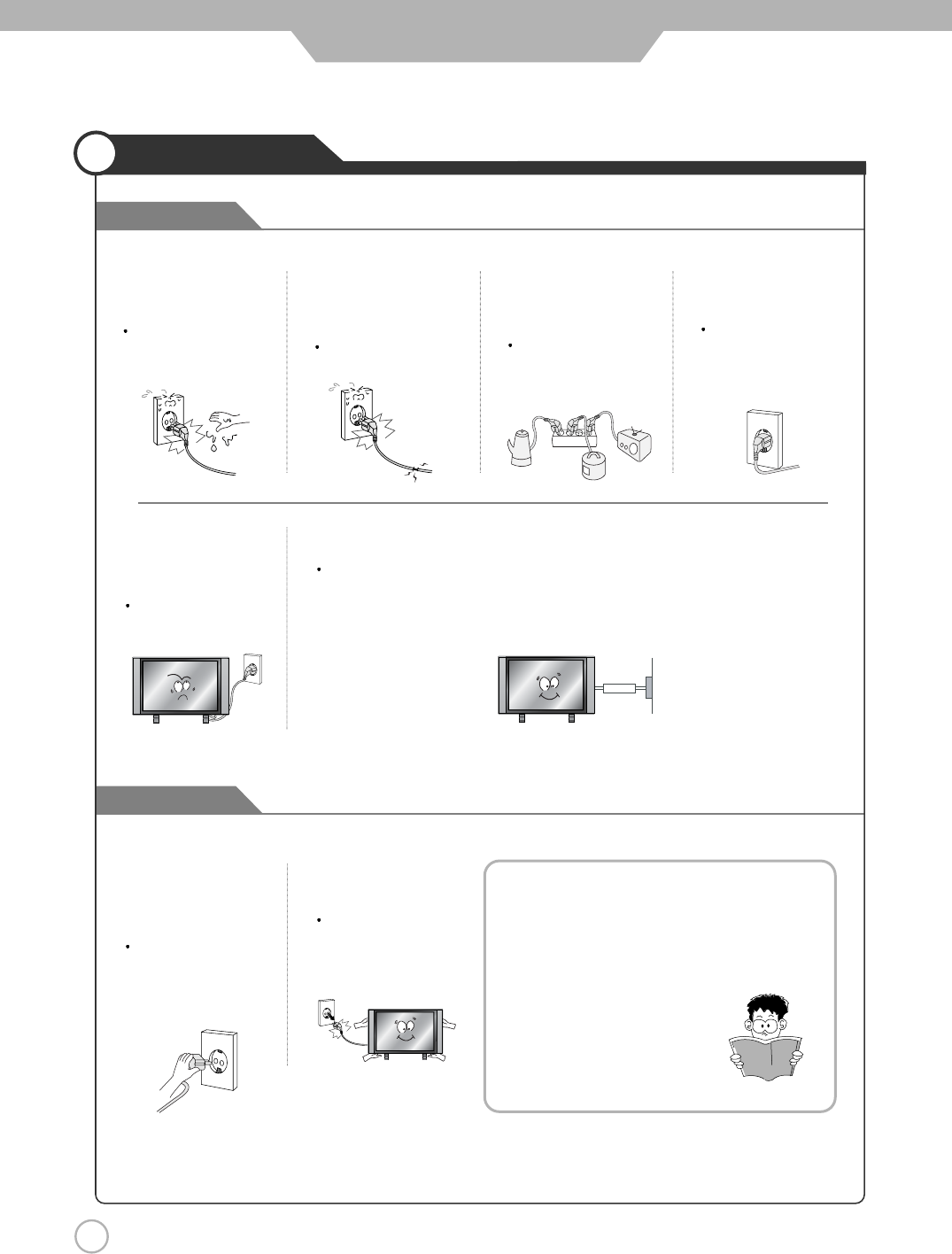
4
Safety Precautions
Cautions
Warnings
Power Supply
Do not use a damaged
power cord or plug or a
loose outlet.
Doing so may result in
fire or electric shock.
Do not plug several
devices into the same
outlet.
Doing so may cause
the outlet to overheat
and start a fire.
Insert the power plug
fully into the outlet.
A loose or improperly
inserted power plug
may result in fire.
Do not touch the power
plug with wet hands.
Doing so may result in
electric shock.
Be sure to ground the unit.
Failing to do so may lead to electric shock when a short circuit or overload occurs.
If necessary, install a ground fault circuit breaker. Never ground to a telephone line,
lightning rod, or metal gas pipe. (Doing so may result in fire, electric shock, or other
hazards.)
Do not bend the power
cord excessively or place
heavy objects on it.
Doing so may result in
fire or electric shock.
Always unplug the unit
before cleaning.
Not doing so may
result in fire or electric
shock.
When disconnecting the
power cord from an AC
outlet, always grasp it by
the plug.
Pulling on the cord
can damage the
internal wire and may
result in fire.
The purpose of these precautions is to
ensure user safety and prevent property
damage.
Be sure to read and observe all safety
precautions.
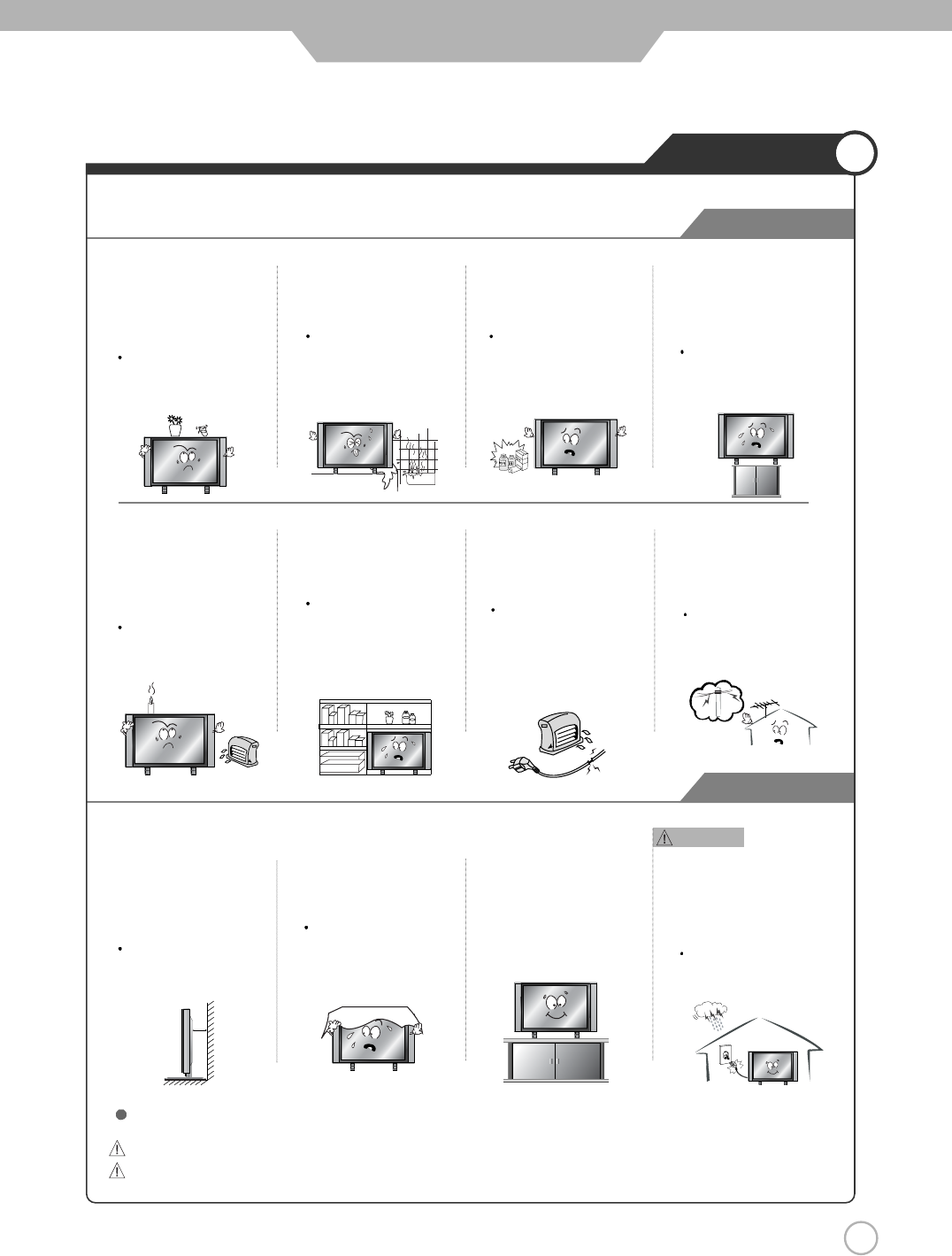
5
Safety Precautions
Cautions
Warnings
Installation
Warnings
Do not place the unit where it
is exposed to rain, excessive
moisture or grease.
Doing so may result in fire,
electric shock, malfunction,
or deformation.
Do not use or store flamm
able or combustible materials
near the unit.
Doing so may result in fire
or explosion.
Do not place the unit on an
unstable surface, such as a
wobbly stand or sloped table, or
on any surface whose area is
smaller than the bottom area of
the unit.
If a child climbs on the unit, it could
topple and fall onto the child,
resulting in serious injury to the
child or damage to the unit. Place
the unit on a flat stable surface
.
Do not place containers with
liquids such as flower vases,
soft drink cans, or medicine
bottles or small metallic objects
on top of the unit.
If liquid enters the unit or any
metal object falls into the unit,
it may result in short-circuit,
fire, or electric shock.
Do not place the unit in a
poorly ventilated enclosure,
such as a cabinet.
Doing so poses a serious
risk of fire.
Do not run power cords near
heat-producing appliances
such as radiators, stoves, or
irons.
The excessive heat could
melt the insulation and
expose live wires, resulting
in fire or electric shock.
Install the antenna away from
high-voltage power lines and
communication cables and
make sure it is installed
securely.
If the antenna touches a power
line, contact with the antenna
could result in fire, electric
shock, serious injury, or death.
Do not place a burning candle,
burning anti-mosquito incense,
or lighted cigarette on top of the
unit. Do not place the unit near
any heat source such as a
fireplace or space heater.
Doing so poses a serious
risk of fire.
Install the unit at an adeq-
uate distance from the
wall to ensure sufficient
ventilation.
If the temperature inside
the unit rises, it may res-
ultin fire.
Do not cover the unit with
a tablecloth, curtain, or
other material.
If the temperature inside
the unit rises, it may result
in fire.
Be sure to place the unit
on a level surface.
Form a drip loop where the
coaxial antenna cable enters
your building to prevent rainwater
from traveling along the cable
and coming in contact with the
antenna input terminal.
If rainwater finds its way inside
the unit, it may result in fire or
electric shock.
The following precautions are divided into "Warnings" and "Cautions".
Warning : Ignoring this precaution may result in death or serious injury.
Caution : Ignoring this precaution may result in injury or property damage.
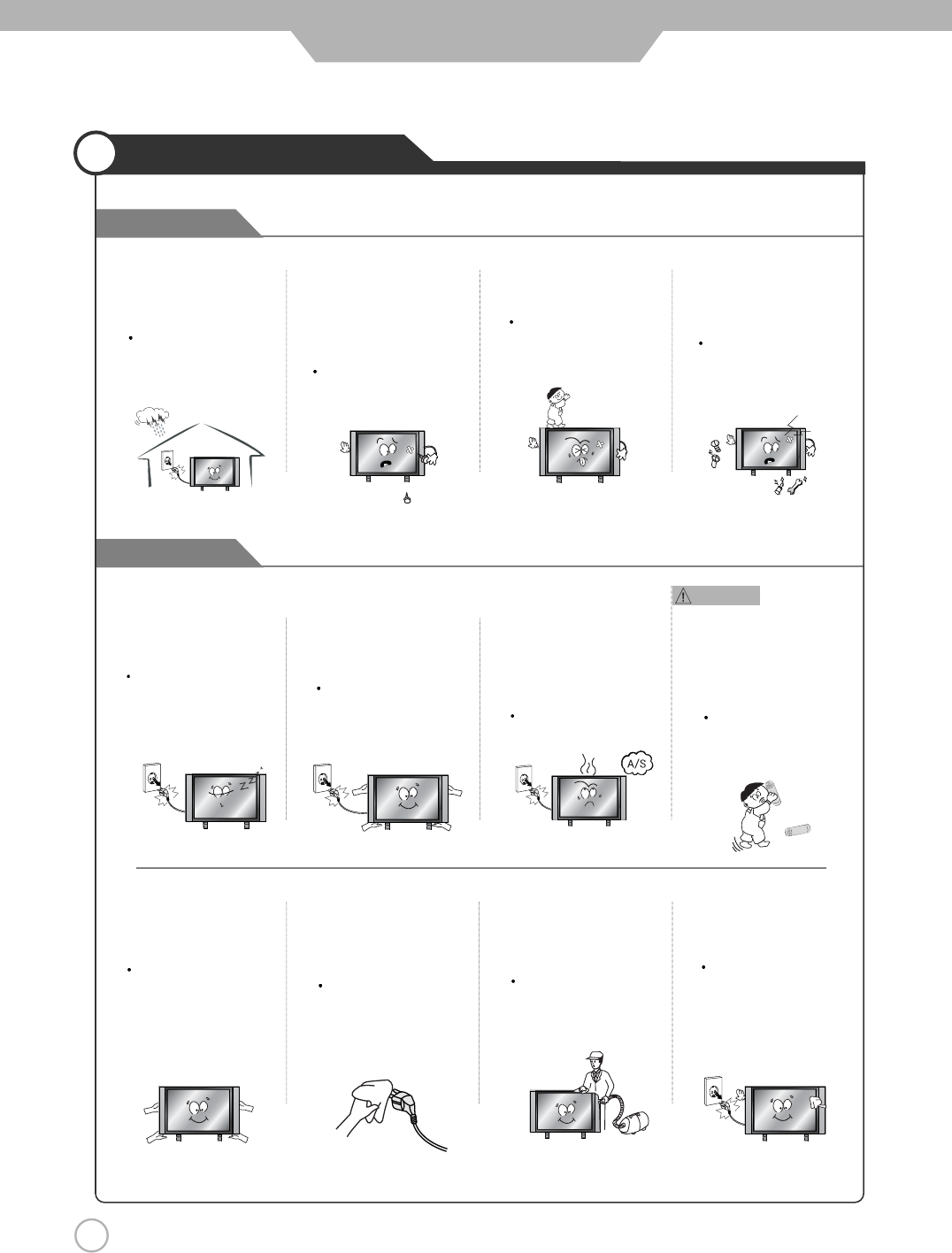
6
Safety Precautions
Warnings
Cautions
Use and Maintenance
Do not insert any metal
objects, such as a screwdriver,
paper clip, or bent wire into
the ventilation openings or
A/V terminals.
Doing so poses a serious
risk of fire or electric shock.
Do not allow children to
climb or hang on the unit.
The unit could topple
over onto a child and
result in serious injury.
Never disassemble or modify
the unit in any way. Do not
attempt to service the unit
yourself.
Doing so may result in fire
or electric shock. If the unit
requires repair, contact the
service center.
Disconnect the power
cord from the wall outlet
during an electrical storm.
Not doing so may result
in fire or electric shock.
When not using the unit for
long periods of time, discon-
nect the power cord from
the wall outlet.
Dust could accumulate over time
on the unit and cause it to
generate heat and ignite, or
deteriorate insulation, which in
turn may result in an electrical fire.
When removing the batteries
from the remote control, make
sure children do not swallow
them. Keep the batteries out
of the reach of infants and
children.
If a child has swallowed a
battery, seek medical atten-
tion immediately.
If you notice any unusual
odors or smoke around the
unit, immediately disconnect
the unit from the outlet and
contact the service center.
Failure to do so may result
in fire or electric shock.
When moving the unit, be
sure to turn off the unit and
unplug the power cord from
the wall outlet.
Moving the unit with the
power cord connected to the
outlet may cause damage to
the cord, resulting in fire or
electric shock.
Wipe off any moisture,
dirt, or dust on the power
plug pins with a clean dry
cloth.
Failure to do so may
result in fire or electric
shock.
Always use two or more
people to lift or move the
unit.
If the unit is dropped, it
could be damaged or
otherwise cause injury.
Always turn off the unit and
unplug the power cord when
cleaning the unit. Use a soft dry
cloth to clean the unit.
Never clean with industrial
strength polish, wax, benzene,
paint thinner, air freshener,
lubricant, detergent, or other
such chemicals. Also, do not
clean with a damp cloth.
It is advisable to clean the
interior of the unit at least once
a year. Contact the store of
purchase or service center for
information.
Continuing to use the unit
without cleaning off the dust
build-up inside it may result
in fire or electric shock.
Warnings

7
Safety Precautions
Important Safety Instructions
Important safeguards for you and your new product
1) Read these instructions.
2) Keep these instructions.
3) Heed all warnings.
4) Follow all instructions.
5) Do not use this apparatus near water.
6) Clean only with a dry cloth.
7) Do not block any of the ventilation openings. Install in accordance with the manufacturer's
instructions.
8) Do not install near any heat sources such as radiators, heat registers, stoves, or other
apparatus (including amplifiers) that produce heat.
9) Do not defeat the safety purpose of the polarized or grounding type plug. A polarized plug
has two blades with one wider than the other. A grounding type plug has two blades and a
third grounding prong. The wide blade or the third prong is provided for your safety. When
the provided plug does not fit into your outlet, consult an electrician for replacement of the
obsolete outlet.
10) Protect the power cord from being walked on or pinched particularly at plugs, convenience
receptacles, and the point where they exit from the apparatus.
11) Only use the attachments/accessories specified by the manufacturer.
12) Use only with a cart, stand, tripod, bracket, or table specified by the manufacturer, or sold
with the apparatus. When a cart is used, use caution when moving the cart/apparatus
combination to avoid injury from tip-over.
13) Unplug this apparatus during lightning storms or when unused for long periods of time.
Always be careful when using your PDP Monitor. To reduce the risk of fire, electrical shock,
and other injuries, keep these safety precautions in mind when installing, using, and
maintaining your machine.
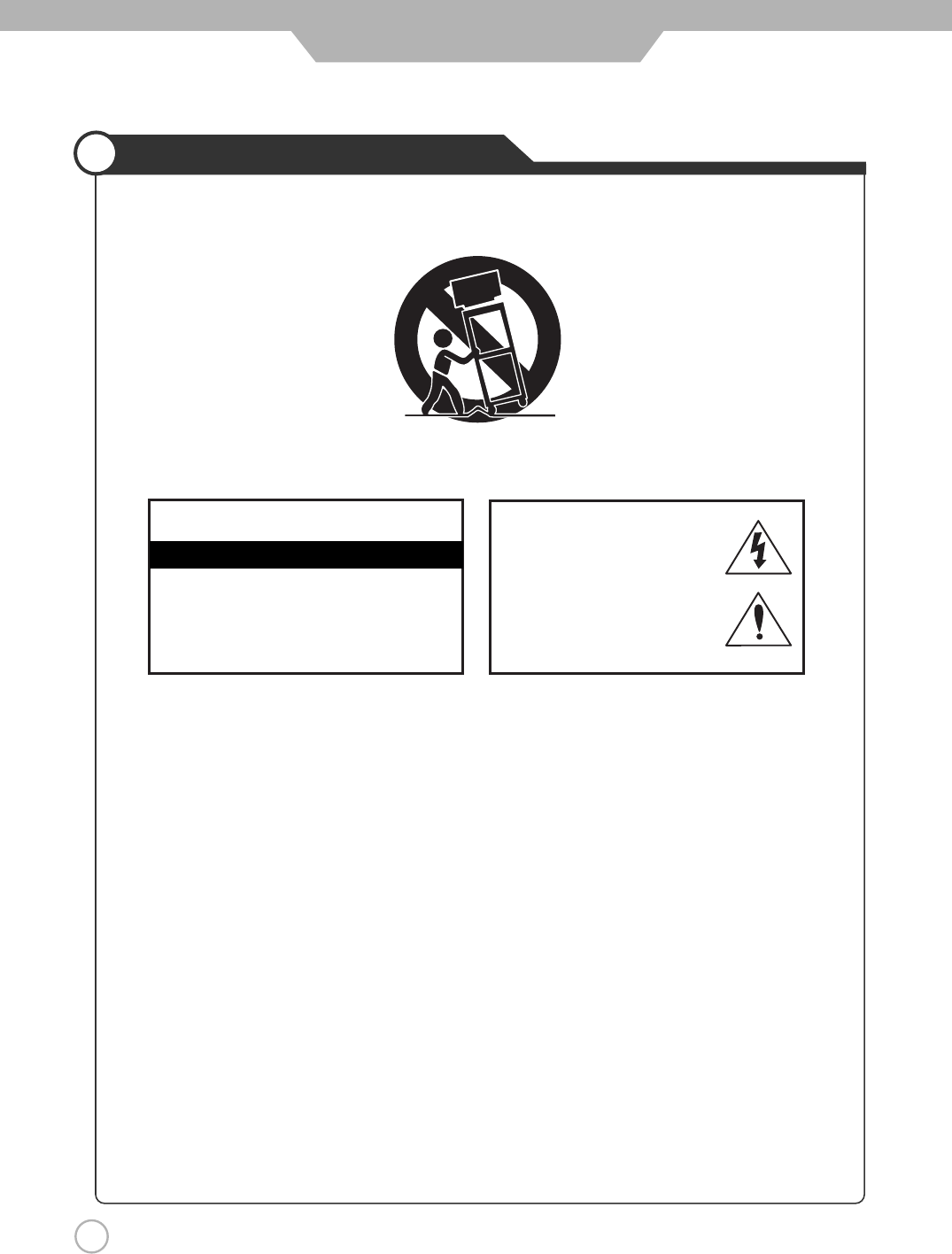
Safety Precautions
8
Important Safety Instructions
- These servicing instructions are for use by qualified service personnel only.
To reduce the risk of electric shock, do not perform any servicing other than that contained in
the operating instructions unless you are qualified to do so.
- Any changes or modifications not expressly approved by the party responsible for compliance
could void the user’s authority to operate the equipment.
A warning that an apparatus with CLASS I construction shall be connected to a MAINS socket
outlet with a protective earthing connection.
To prevent injury, this apparatus must be securely attached to the floor/wall in accordance with
the installation instructions.
Caution :
TO PREVENT DAMAGE WHICH MAY RESULT IN FIRE OR ELECTRIC SHOCK HAZARD,
DO NOT EXPOSE THIS APPLIANCE TO RAIN OR MOISTURE.
WARNING
CAUTION
RISK OF ELECTRIC SHOCK DO NOT OPEN
CAUTION : TO REDUCE THE RISK OF ELE-
CTRIC SHOCK, DO NOT REMOVE COVER
(OR BACK). NO USER SERVICEABLE PARTS
INSIDE. REFER SERVICING TO QUALIFIED
SERVICE PERSONNEL.
This symbol indicates high voltage
is present inside. It is dangerous
to make any kind of contact with
any inside part of this product.
This symbol alerts you that
important literature conceming
operation and maintenance has
been included with this product.

9
Important Safety Instructions
One Federal Court has held that unauthorized recording of copyrighted TV programs is an
infringement of U.S. copyright laws.
Certain Canadian programs may also be copyrighted and any unauthorized recording in whole or
in part may be in violation of these rights.
Important :
This equipment has been tested and found to comply with the limits for a Class B digital device,
pursuant to Part 15 of the FCC Rules. These limits are designed to provide reasonable protection
against harmful interference when the equipment is operated in a residential installation. This
equipment generates, uses and can radiate radio frequency energy and, if not installed and used in
accordance with the instruction manual, may cause harmful interference to radio communications.
However, there is no guarantee that interference will not occur in a particular installation. If this
equipment does cause harmful interference to radio or television reception, which can be
determined by turning the equipment off and on, the user is encouraged to try to correct the
interference by one or more of the following measures:
• Reorient or relocate the receiving antenna.
• Increase the separation between the equipment and receiver.
• Connect the equipment into an outlet on a circuit different from that to which the receiver is connected.
• Consult the dealer or an experienced radio/TV technician for help.
REGULATORY INFORMATION :
- These servicing instructions are for use by qualified service personnel only.
To reduce the risk of electric shock, do not perform any servicing other than that contained in
the operating instructions unless you are qualified to do so.
- Any changes or modifications not expressly approved by the party responsible for compliance
could void the user’s authority to operate the equipment.
Caution :
TO PREVENT DAMAGE WHICH MAY RESULT IN FIRE OR ELECTRIC SHOCK HAZARD,
DO NOT EXPOSE THIS APPLIANCE TO RAIN OR MOISTURE.
WARNING
Safety Precautions
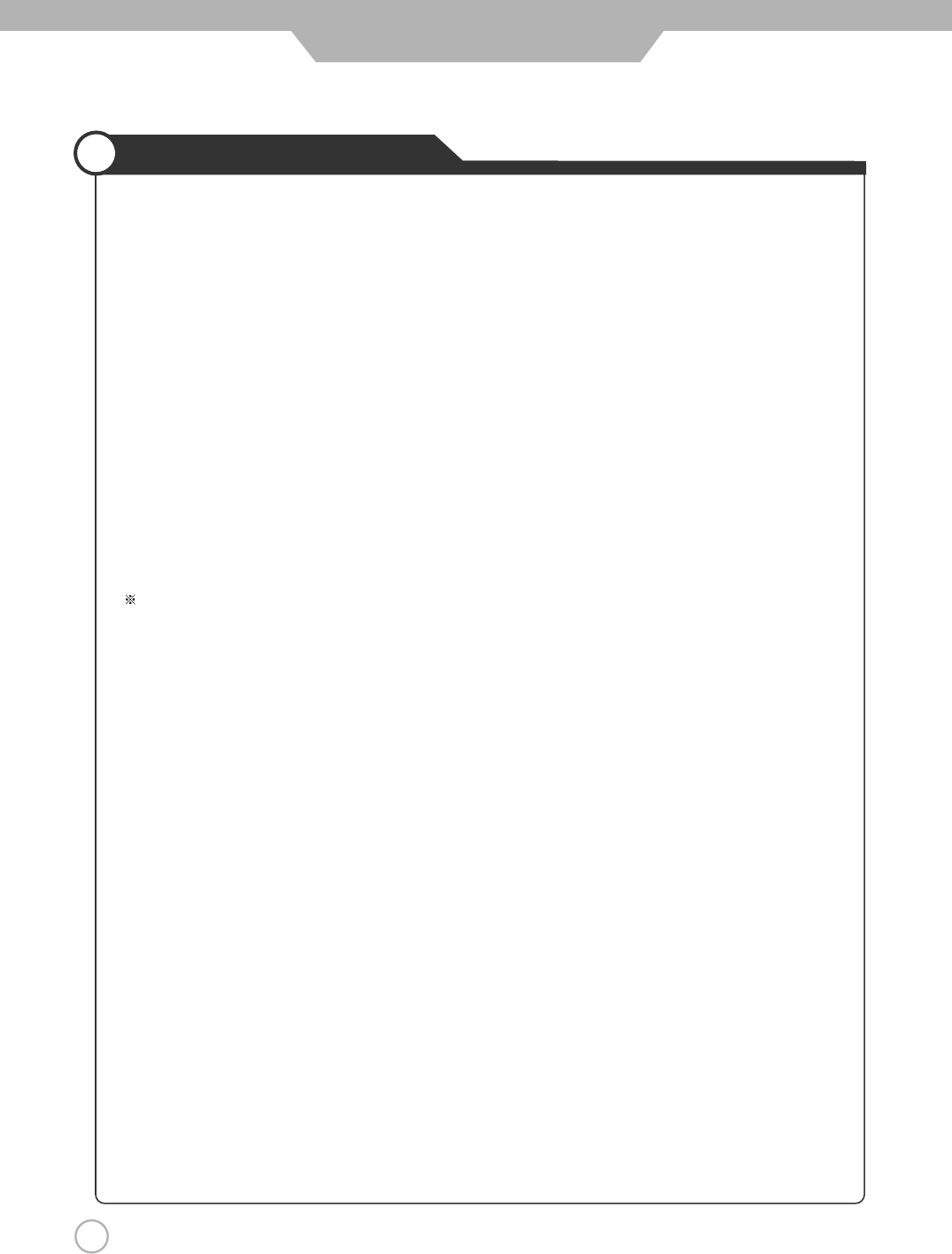
10
Still image (immovable) screen may cause permanent damage to
PDP Monitor.
1. Lengthy display of still images from video games, banners, graphics and others may fatally damage
the screen.
2. When using Picture-In-Picture, permanent damage may occur if the sub-image screen stays on the
corner of screen for a long time.
3. When using the PDP Monitor in 4 : 3 formats with sidebars for a long period of time, it may cause
damage to the plasma panel. It is recommended that you use Wide(16 :9) or Panorama format.
(Image burn-in can be avoided by using "Panel Protection" function or a screen-saver. However,
once image burn-in occurs, it may not disappear completely. An image will be dimmed as the image
is displayed long time or repeatedly.)
Any damage to the PDP Monitor caused by improper usage (such as image burn-in) shall not be
covered by the warranty.
Defective pixels that can be seen on PDP Monitor screen.
(illuminated spots, bright spots, blind spot, blinking)
Generally, PDP Monitor consists of about 1.22 million pixels and having defective pixels is possible. A
PDP Monitor with a number of defective pixels below a certain number is not considered defective. The
limited number of defective pixels does not affect the performance or reliability of the PDP Monitor. The
standard of inspection regarding defective pixels is the same or better as the competitor's offering on
similar PDP Monitor. It is not subject to replacement or a refund. We will do our best to minimize the
defective pixel as best as we can.
Considerations For Usage
Safety Precautions
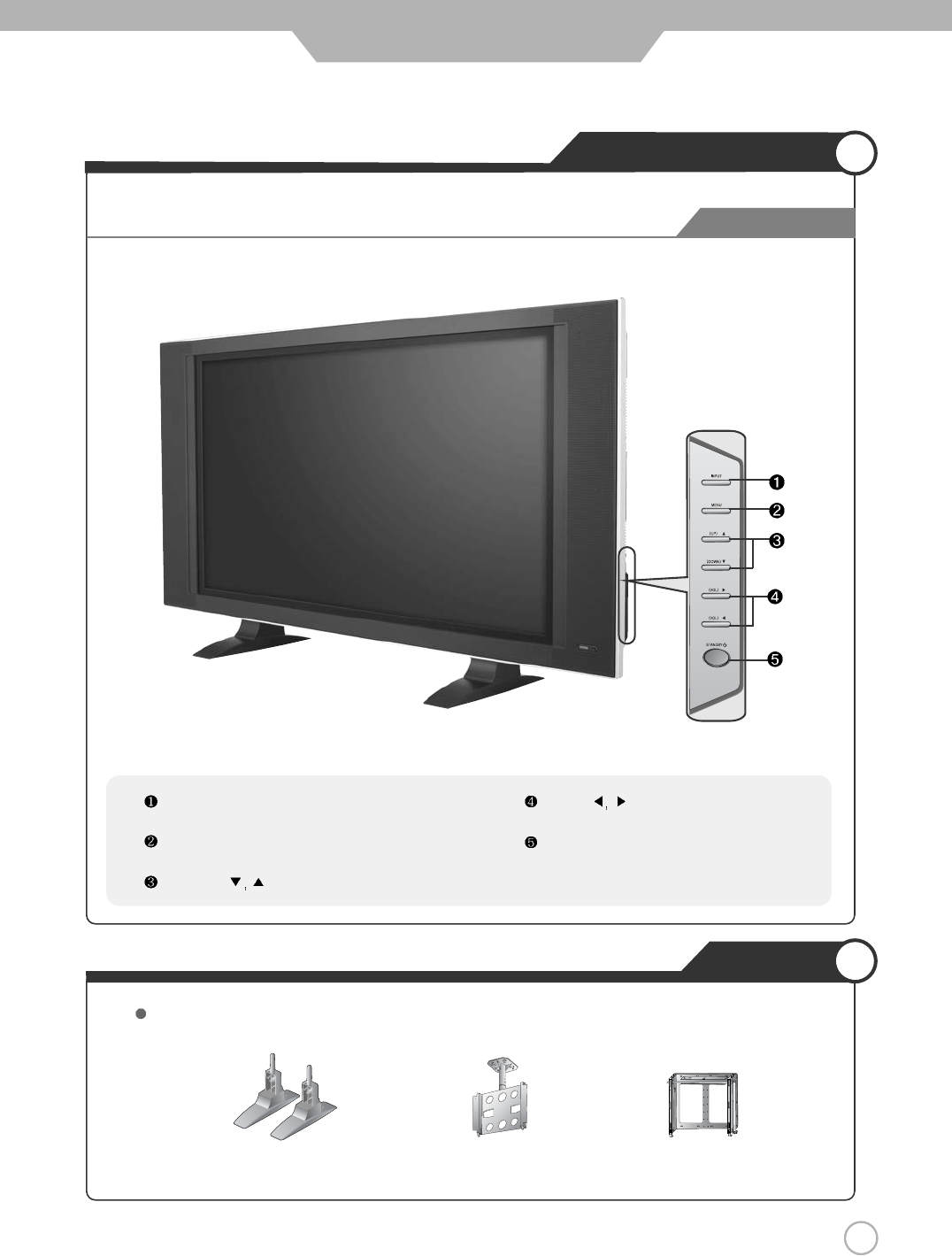
11
Names of each part
Ceiling - Mount Bracket Adjustable - Angle
Wall mount
To improve the quality of the PDP Monitor, specification is subject to change without notice. Please contact your dealer
for current options available.
Stand
Front View
Options
User Guidance Information
Input Button
Menu Button
Up / Down Button
Volume Button
Standby Button
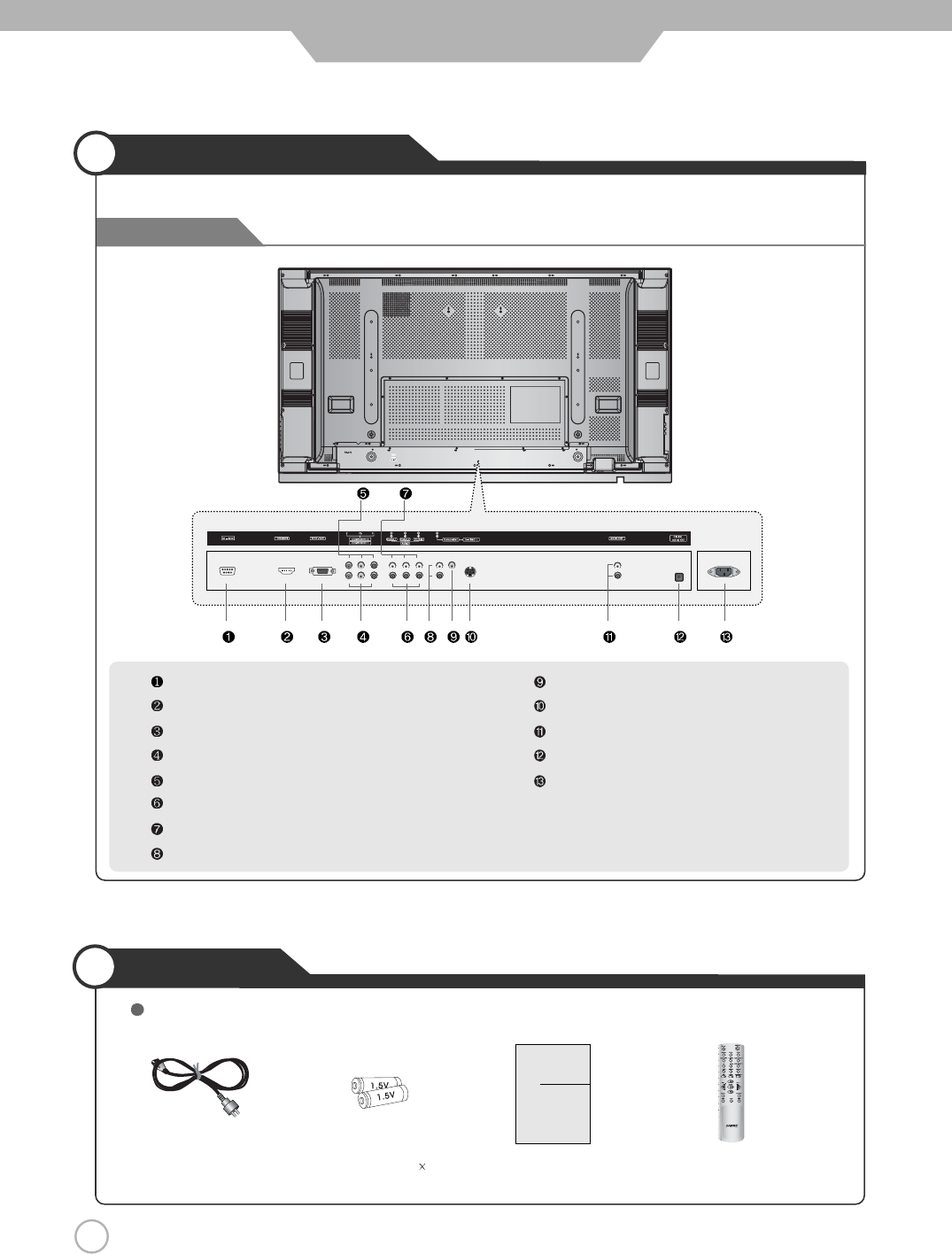
12
RS-232C Terminal
HDMI/DVI Terminal
Analog PC Terminal
Component 1 Terminal
Component 2 Terminal
PC Audio Input Terminal
Component 1 Audio Terminal
Component 2 Audio Terminal
Composite 1 Terminal
S-Video
Stereo Output
OPTICAL (Digital Audio output)
AC Input
Back View
User Guidance Information
Controls and Functions
The configuration of the components may look different from the following illustration.
Power Cord Battery 1.5V( AAA 2) User's Guide
Remote Control
User's Guide
Accessories
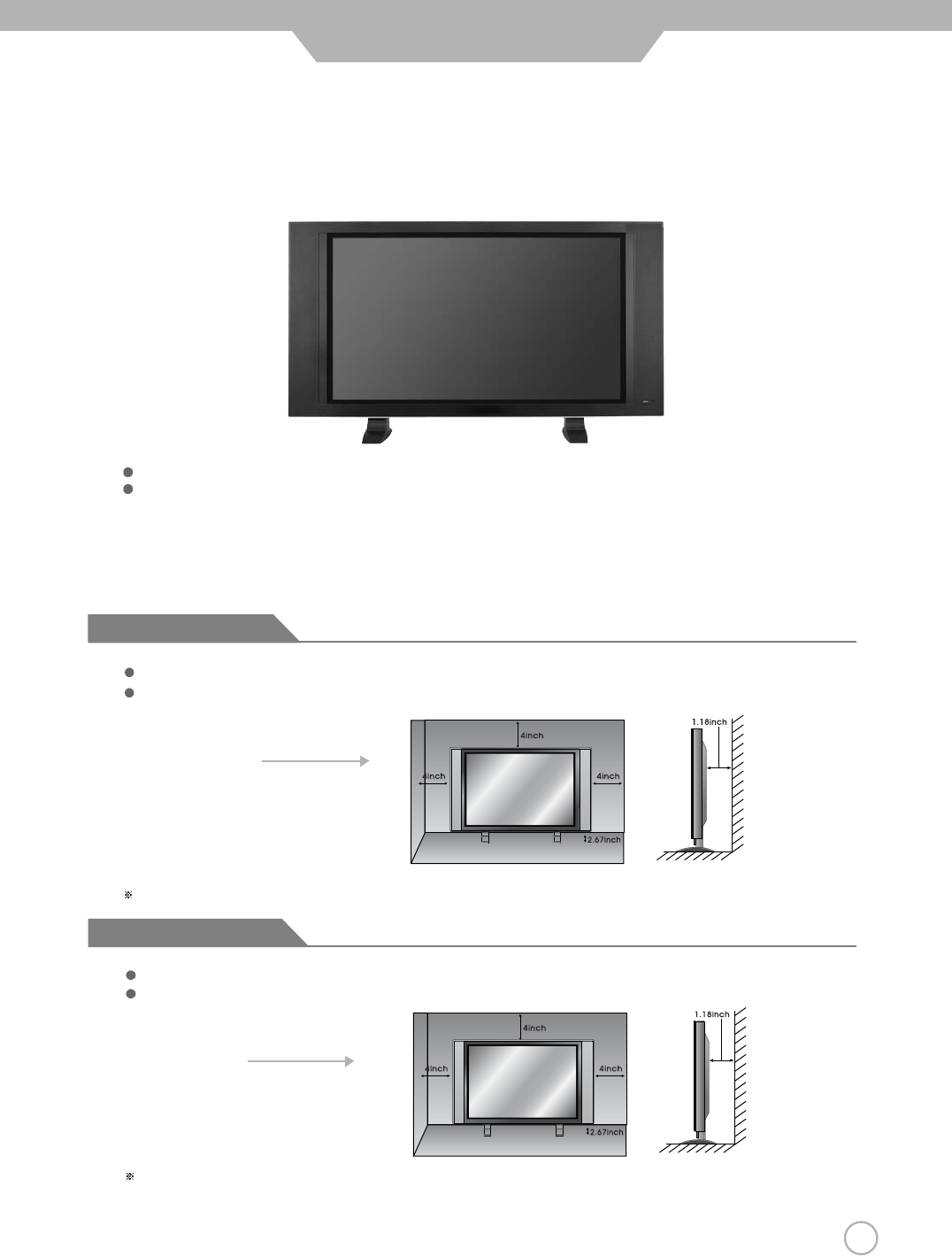
13
Installation Precautions
Wall Mounting
Using the Stand
Please secure enough space for safe use. (Please refer to A and B.)
Installation of the PDP Monitor in an improperly ventilated location can cause a fire or damage to the PDP
Monitor due to increased temperature
.
(Using the Stand)
B
(Mounting on a wall)
A
Do not install on an unstable location with support area smaller than the PDP Monitor.
Please refer to the desktop stand user's manual for details of installation.
Contact your dealer to purchase the "Adjustable-angle wall mount" required for wall-mounted installation.
Please contact your dealer to purchase the "speakers".
Mounting on a Desktop
User Guidance Information
Your PDP Monitor can be mounted on a Desktop as shown in the figure above.
This is not floor-standing unit.
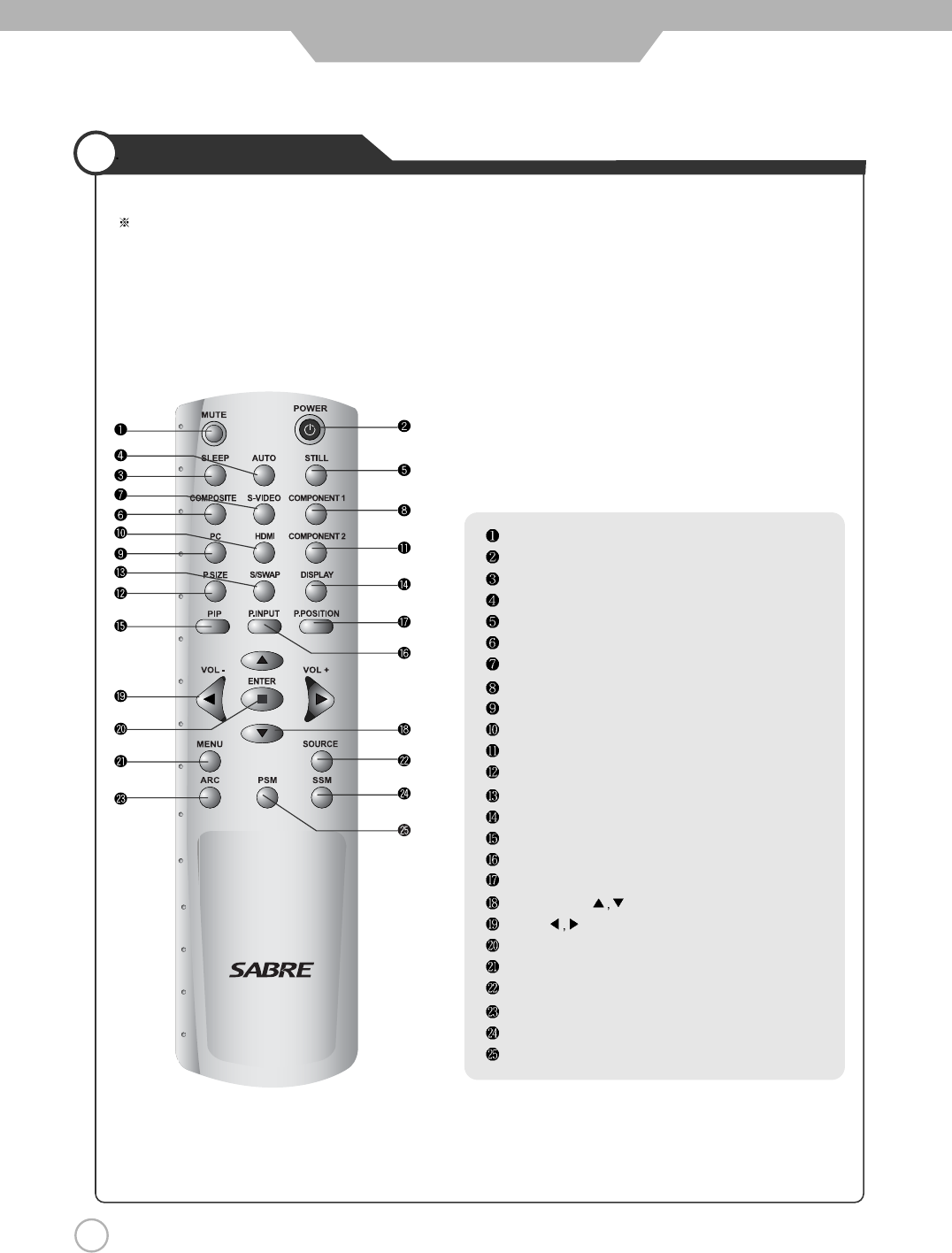
14
Functions of remote controller buttons
The remote controller is using Infra-Red (IR). Point it towards the front of the PDP. The remote controller may not
work correctly if it is operated out of range or out of angle.
MUTE :
SOUND MUTE KEY
POWER :
POWER ON/OFF KEY
SLEEP :
SLEEP TIMER KEY
AUTO :
PC INPUT SIGNAL ADJ
STILL :
FREEZE KEY
COMPOSITE :
COMPOSITE INPUT SELECT KEY
S-VIDEO :
S-VIDEO INPUT SELECT KEY
COMPONENT1 :
COMPONENT1, INPUT SELECT KEY
PC :
PC INPUT SELECT KEY
HDMI :
HDMI/DVI INPUT SELECT KEY
COMPOENET2 :
COMPONENT2 INPUT SELECT KEY
P.SIZE :
PIP SIZE SELECT KEY
S/SWAP :
SOUND SWAP KEY
DISPLAY : INFORMATION DISPLAY KEY
PIP :
PIP ON/OFF CONTROL KEY
P.INPUT :
PIP INPUT SOURCE SELECT KEY
P.POSITION :
PIP POSITION SELECT KEY
UP/ DOWN ( ) :
MENU CONTROL KEY
VOL ( ) :
VOLUME +/- OR MENU CONTROL KEY
ENTER :
SAVE THE VALUE
MENU :
OSD MENU DISPLAY KEY
SOURCE :
MAIN INPUT SOURCE SELECT KEY
ARC :
ASPECT RATIO CONTROL KEY
SSM :
SOUND STATUS MODE KEY
PSM :
PICTURE STATUS MODE KEY
Remote controller
User Guidance Information
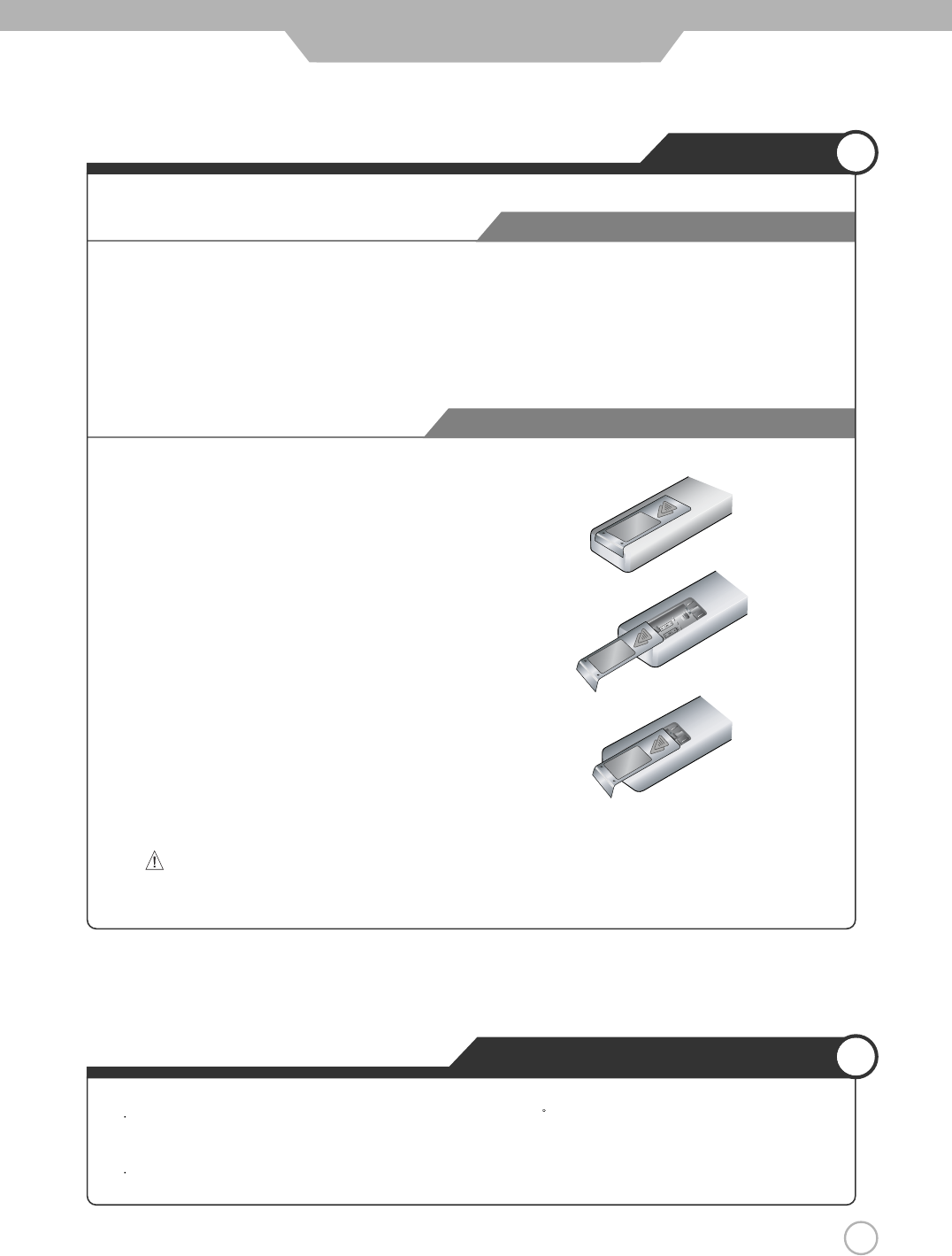
15
Avoiding Remote Control Problems
Instering Batteries in the Remote Controller
Precautions
How to use remote controller
2. Insert the two supplied batteries (AAA, 1.5V). Ensure
that the polarities (
+
and
-
) of the batteries are aligned
correctly.
1. Open the cover out completely.
3. Replay the cover.
1. Check the polarity (
+
,
-
) of the batteries in the remote controller.
2. Check that the batteries have power.
3. Check that the PDP Monitor is powered and that it is properly plugged in.
4. Check if any three-wavelength lamp, special fluorescent or neon sign is turned on near the PDP Monitor.
CAUTION : Risk of explosion if battery is replaced by an incorrect type.
Dispose of used batteries according to the national code (Recycling program).
The remote control should be operated within 23feet(7m) and 30 to the left and the right of the IR receiver
on the front of the PDP Monitor.
Used batteries should be disposed properly.
15
User Guidance Information
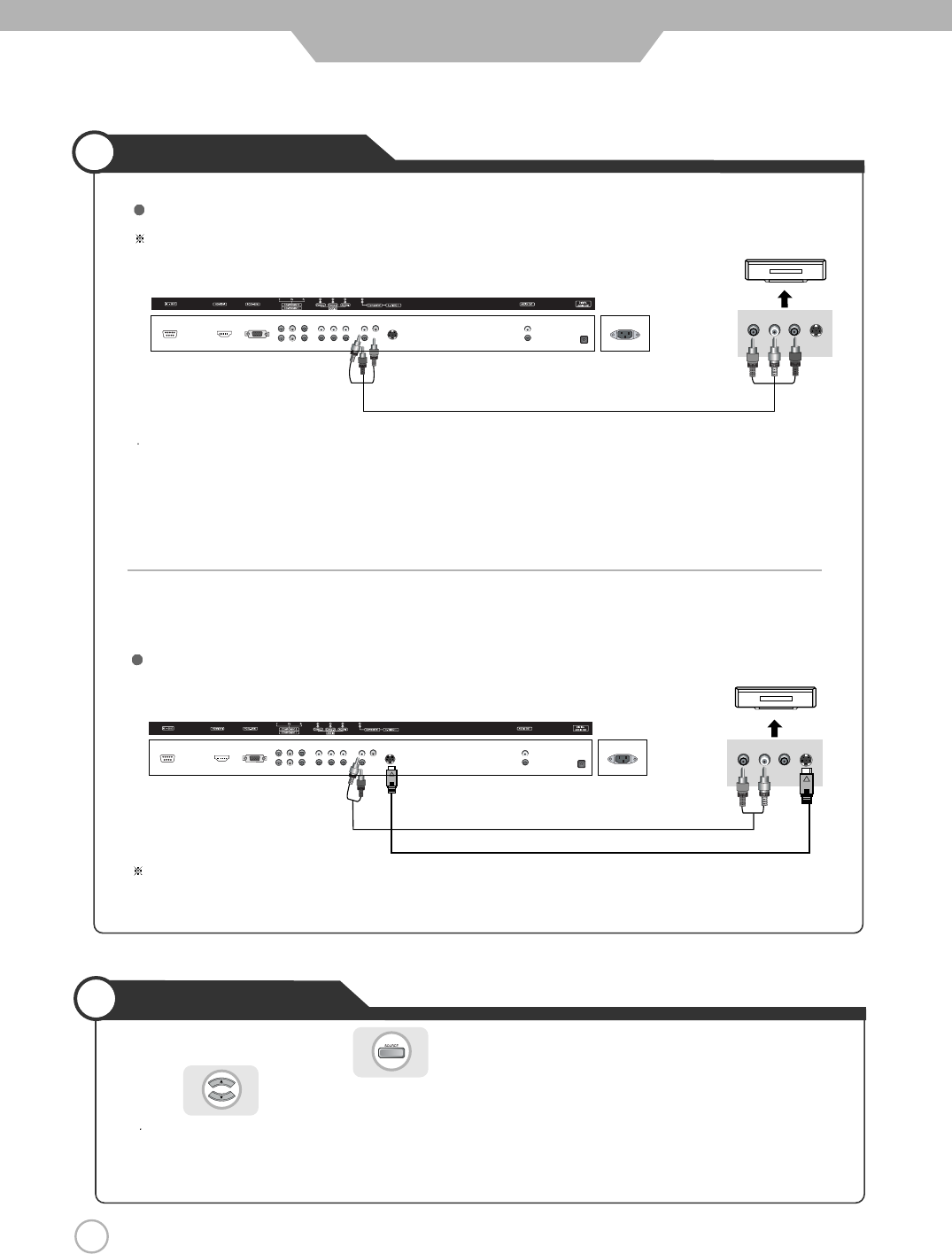
16
1. Turn on the PDP Monitor and press on the remote controller.
2. Use to move to "Composite".
If S-Video has been connected, select "S-Video".
3. Turn on the VCR, insert the tape and press play button.
VCR Connections
Connect the PDP Monitor's Composite terminal to the VCR's Composite Out terminal using the Composite cable.
(Make sure the colour of the terminals and the colour of the cable are the same)
Use the S-Video cable for higher picture quality.
Connection terminals of other appliances differ by manufacture and model.
< PDP Monitor Back view >
< PDP Monitor Back view >
Composite Cable
S-Video Cable
Auto Cable
< VIDEO >
(R) (L)
< VIDEO >
(R) (L)
Connecting to the composite terminal
Connecting to the S-Video terminal
Playing the VCR
16
Connection
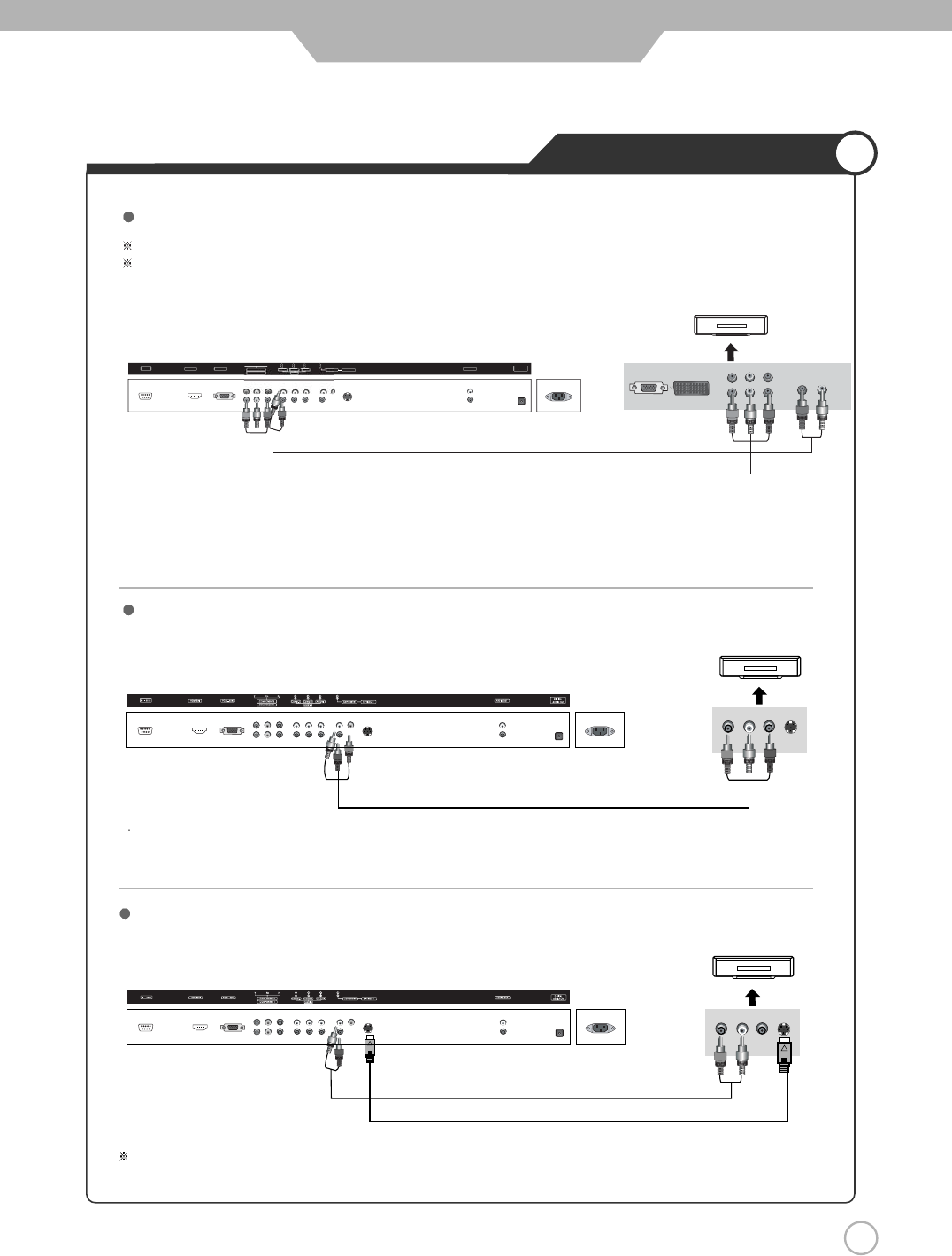
17
Connect the PDP Monitor's Composite terminal to the Cable broadcasting receiver’s Composite Out terminal using the
Composite cable. (Make sure the colour of the terminals and the colour of cable are the same)
In order to watch Cable TV, Subscribe to your local Cable TV company and install a separate converter(Set-Top-Box)
Connection terminals of other appliances differ by manufacture and model.
Composite Cable
< PDP Monitor Back view >
(R) (L)
< Cable broadcasting receiver >
Connecting to the component terminal
Connecting to the composite terminal
17
Connection
< PDP Monitor Back view >
Component cable
Audio cable
(R) (L)
1. Connect PDP Monitor's Y, Pb,Prterminal in Component 1/2to the Cable broadcasting receiver’s Component Out
terminal using the component cable.
2. Connect PDP Monitor's Audio terminals (left & right) in Component 1/2to the Cable broadcasting receiver’s Audio Out
terminal using the Audio cable.
PrPbY
< Cable broadcasting receiver >
S-Video cable can be used if there is an S-Video terminal.
S-Video Cable
Audio Cable
< PDP Monitor Back view >
< Cable broadcasting receiver >
(R) (L)
Connecting to S-Video terminal
Cable TV Connections
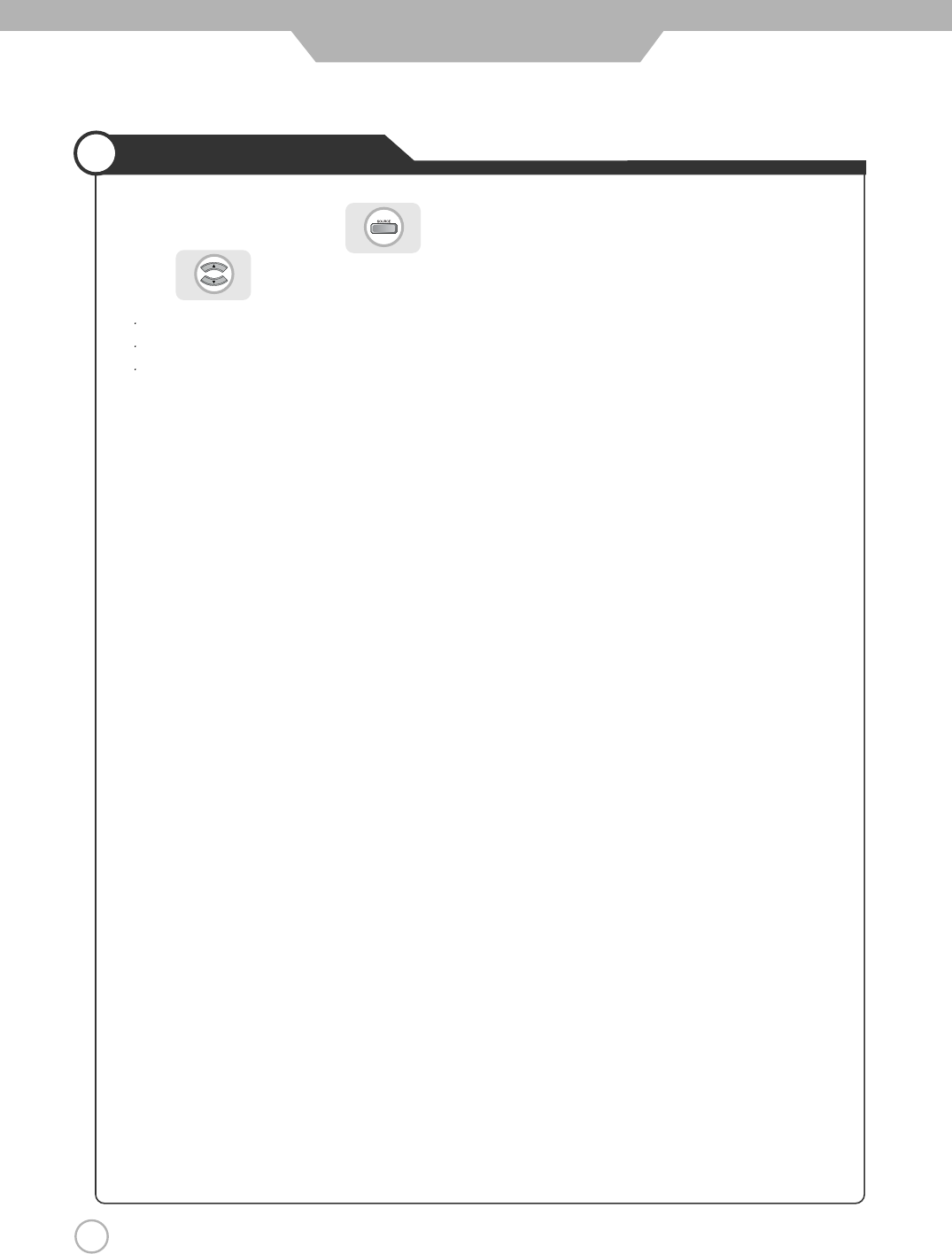
18
Connection
Viewing Cable TV
1. Turn on the PDP Monitor and press on the remote controller.
2. Use to move to "Component1/2".
If S-Video has been connected, select "S-Video".
If SCART terminal has been connected, select “SCART1” or “SCART2”.
If Composite has been connected, select “Composite”.
3. Turn on the cable broadcasting receive and select the channel you wish to view.
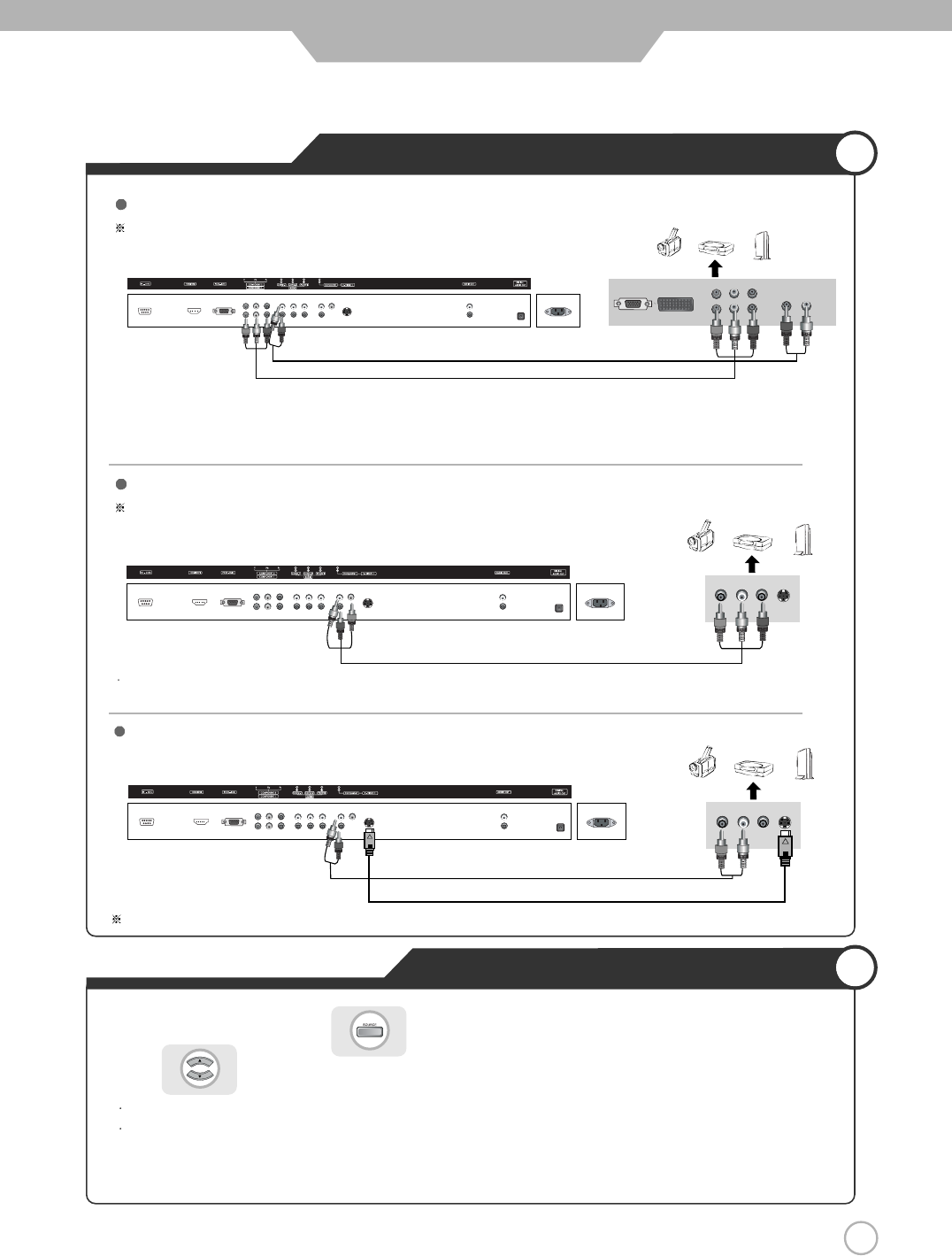
19
Camcorder/Game Console Connections
Using Camcorder/Game Console
1. Turn on the PDP Monitor and press on the remote controller.
2. Use to move to "Component 1/2".
If S-Video has been connected, select "S-Video".
If Composite has been connected, select “Composite”.
3. Turn on the Camcorder or video game and Set to Video mode.
(Please refer to the User's manual of Camcorder/ Video game for more information)
4. Insert tape into Camcorder and press play button or insert disc into the Video game console.
Connection
Connection terminals of other appliances differ by manufacture and model.
< PDP Monitor Back view >
< PDP Monitor Back view >
Composite Cable
Connect the PDP Monitor's Composite terminal to the camcorder/game console's Composite Out terminal with the
Composite cable. (Make sure the colour of the terminals and the colour of cable are the same)
S-Video cable can be used if there is an S-Video terminal.
Connecting to the component terminal
Connection terminals of other appliances differ by manufacture and model.
Connecting to the composite terminal
Connecting to S-Video terminal
(R) (L)
(R) (L)
< Camcorder/ Game machine >
1. Connect PDP Monitor's Y, Pb,Prterminal in Component 1/2to the Camcoder/game console’s Component Out terminal with
the Component cable.
2. Connect PDP Monitor's Audio terminals (left & right) in Component 1/2to the Camcoder/game console’s Audio Out terminal
using the Audio cable.
< Camcorder/ Game machine >
< Camcorder/ Game machine >
S-Video Cable
Audio Cable
< PDP Monitor Back view >
Component cable
Audio cable
(R) (L)
PrPbY
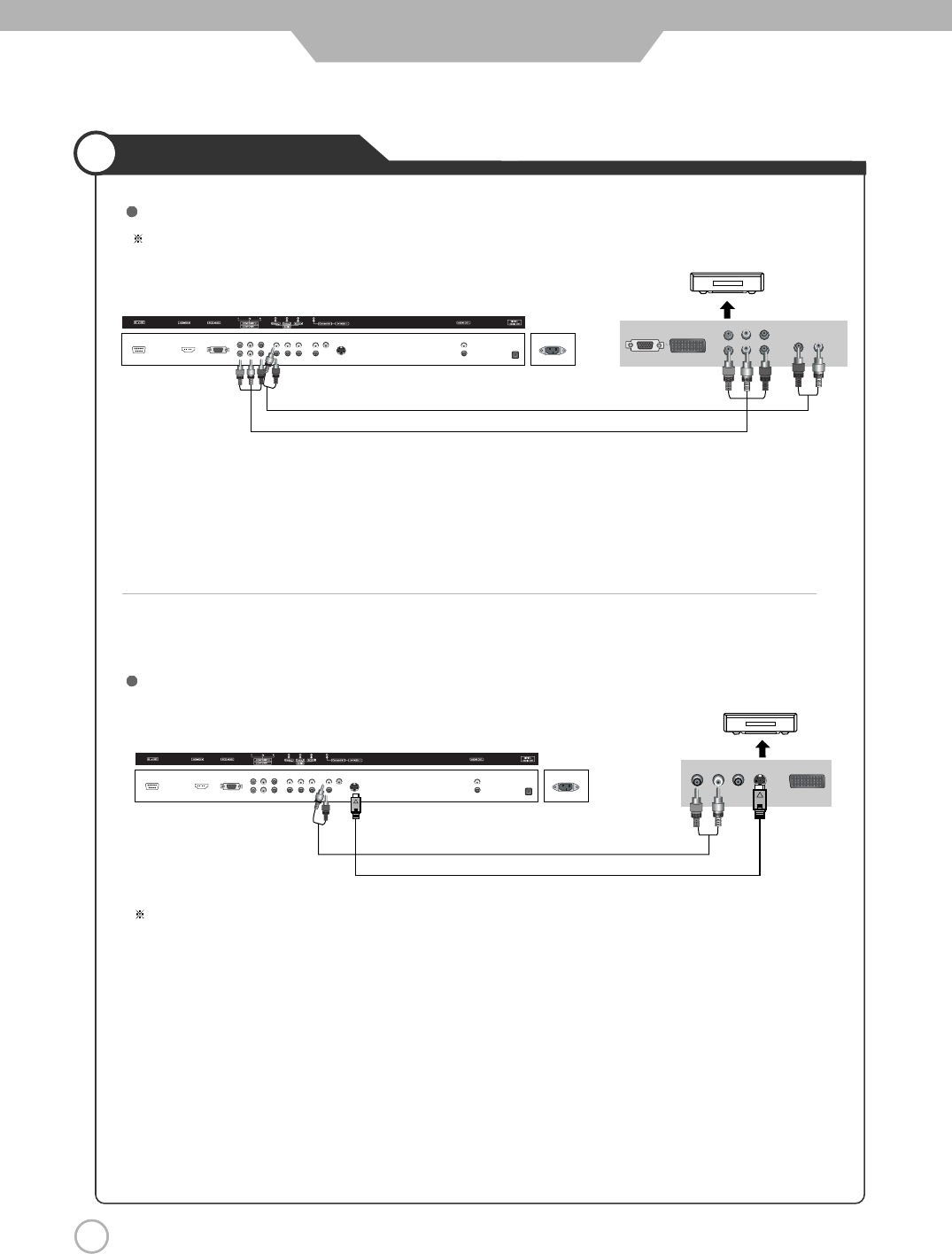
20
DVD Connections
Connection
Connection terminals of other appliances differ by manufacture and model.
< PDP Monitor Back view >
< PDP Monitor Back view >
Component cable
Audio cable
(R) (L)
1. Connect PDP Monitor's Y, Pb,Prterminal in Component 1/2to DVD's Video Out terminal using the Component cable.
2. Connect PDP Monitor's Audio terminals (left & right) in Component 1/2to DVD's Audio Out terminal using the Audio
cable.
S-Video cable can be used if there is an S-Video terminal.
Connecting to the component terminal
Connecting to the S-Video terminal
PrPbY
S-Video Cable
Audio Cable
< DVD >
< DVD >
(R) (L)
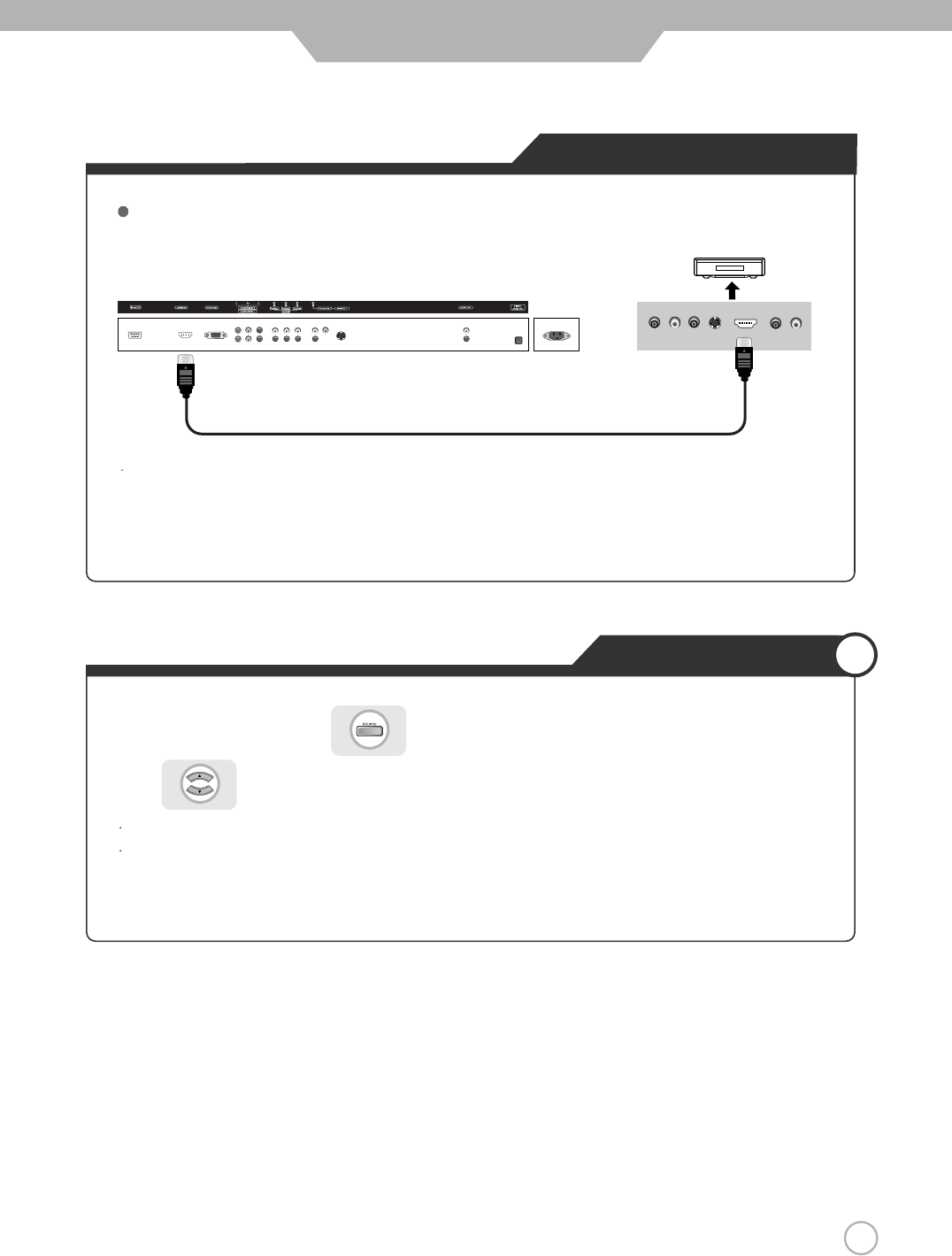
21
Connection
DVD Connections
Playing the DVD
1. Turn on the PDP Monitor and press on the remote controller.
2. Use to move to "Component 1/2".
If S-Video has been connected, select "S-Video".
If HDMI terminal has been connected, select “HDMI”.
3. Turn on the DVD, insert the DVD and press Play button.
< PDP Monitor Back view >
Connect the HDMI terminal of the PDP Monitor to the DVD with the HDMI cable.
Connecting to the HDMI terminal
HDMI Cable
< DVD >
(R) (L)
PrPbY
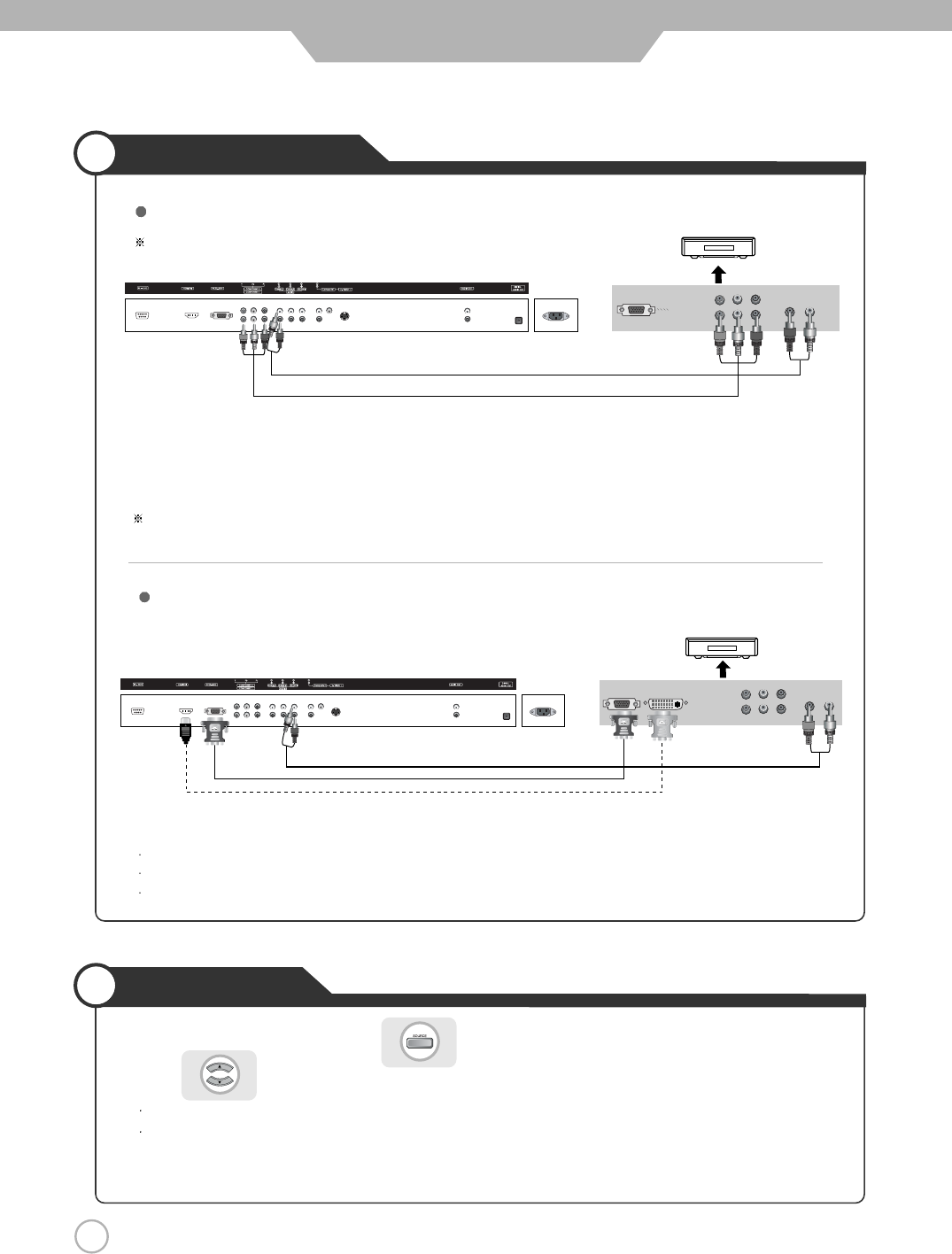
22
Viewing DTV
1. Turn on the PDP Monitor and press on the remote controller.
2. Use to move to "Component 1/2".
If D-Sub 15 Pin terminal has been connected, select “PC”.
If HDMI terminal has been connected, select "HDMl".
3. Turn on the DTV receiver and select the channel that you want.
DTV Connections
22
Connection
< PDP Monitor Back view >
< PDP Monitor Back view >
1. Connect PDP Monitor's Y, Pb,Prterminal in Component 1/2to Video receiver's Video Out terminal using the Component
cable.
2. Connect PDP Monitor's Audio terminals (left & right) in Component 1/2to DTV receiver's Audio Out terminal using
the Audio cable.
DTV receiver's output terminal can be marked Y, Pb,Pror Y, Cb, Craccording to products.
Some of DTV receiver(Set-Top-Box) have an PC Connector (D-Sub 15pin) instead of Component output .
Some of DTV receiver(Set-Top-Box) have an DVI Connector instead of Component output .
Connect Audio Cable from the Audio output terminal of receiver to the PC Audio input terminal of the PDP Monitor.
Connecting to the component terminal
Connecting to the D-SUB or HDMI terminal
Connection terminals of other appliances differ by manufacture and model.
(R) (L)
< DTV receiver>
(R) (L)
PrPbY
< DTV receiver>
Audio Cable
Audio Cable
Component Cable
HDMI to DVI Cable
D-SUB Cable
Audio Cable
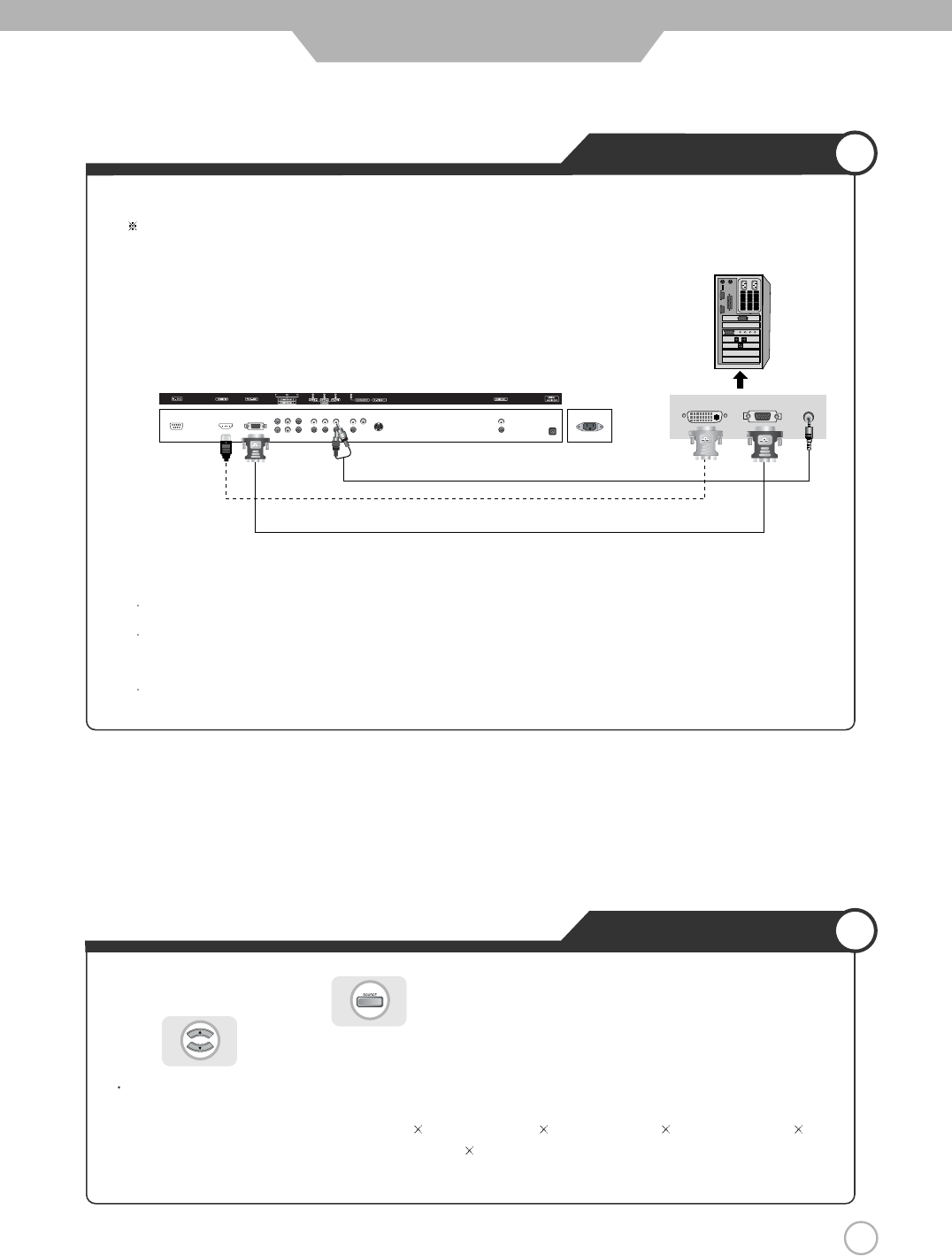
23
PC Connections
How to Use as PC
PC Connections
23
Connection
Connect PDP Monitor's RGB terminal to PC's RGB terminal using the D-Sub cable.
Connect PDP Monitor's PC Audio terminal to PC's Audio terminal using the Audio cable.
(Only possible for PC's with Audio terminal)
If there is a DVI- D terminal in your PC, use the HDMI to DVI cable connection.
1. Turn on the PDP Monitor and press on the remote controller.
2. Use to move to "PC".
If HDMI has been connected, select "HDMI".
3. Set the PC video output mode to VGA (640 480)/ SVGA (800 600)/ XGA (1024 768), SXGA (1280
1024, 60Hz). In the mode higher than SXGA (1280 1024, 60Hz) "Out of Range" message appears. Be
sure to change your PC video format to less than SXGA mode.
< PDP Monitor Back view >
< PC >
Connection terminals of other appliances differ by manufacture and model.
HDMI to DVI Cable
Audio Cable
D-SUB Cable
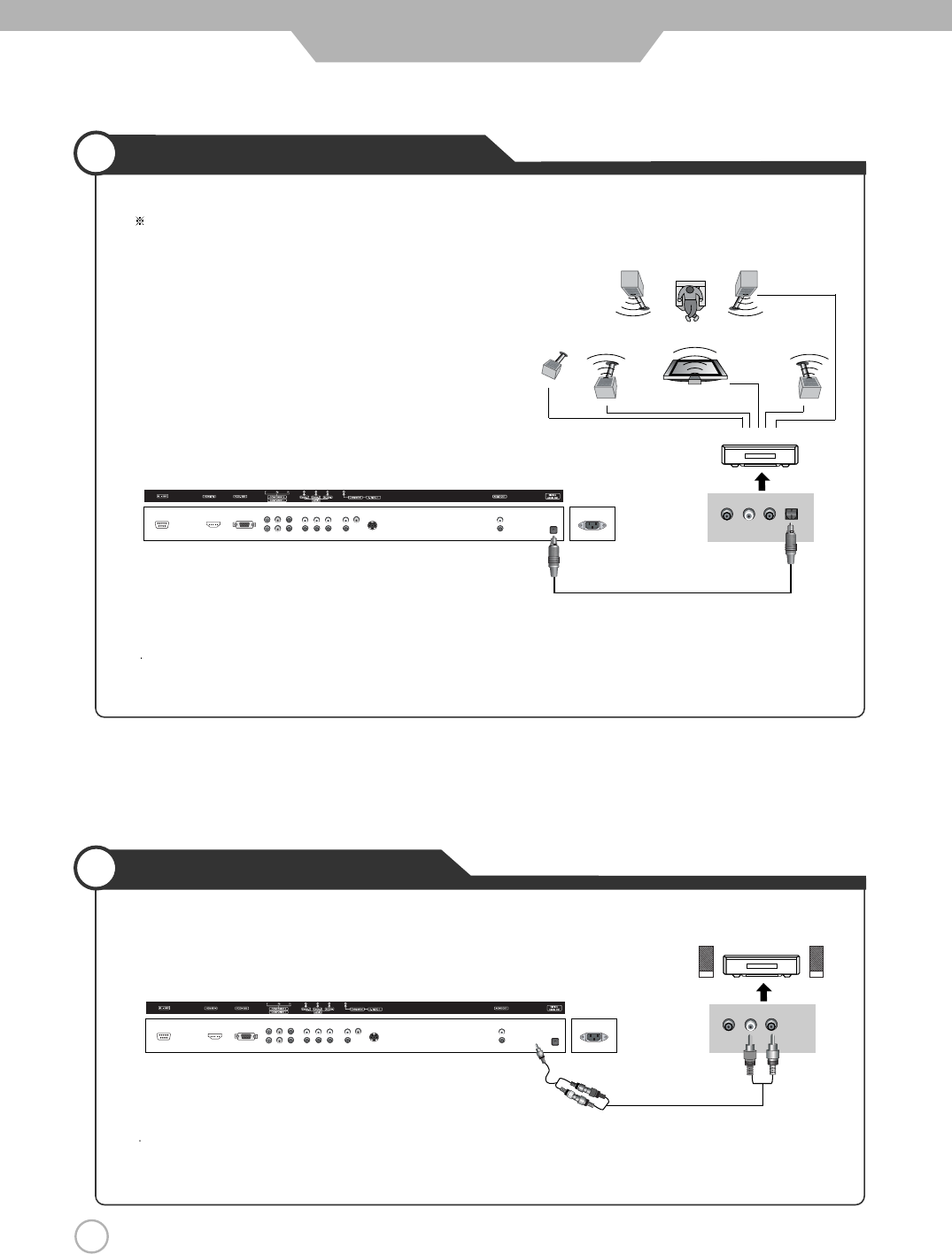
24
Connection
Home Theater Connections
Stereo Out Connections
< PDP Monitor Back view >
Connect PDP Monitor's Digital Audio Out terminal to Home Theater’s Optical terminal using the Optical Cable.
Connect PDP Monitor’s Stereo Out terminal to Audio’s Audio out terminal using the Audio Out Cable.
Connection terminals of other appliances differ by manufacture and model.
(R)
VIDEO (L)
< Home Theater>
(R)
VIDEO (L)
< AUDIO>
< Speaker> < Speaker>
< PDP Monitor Back view >
Optical Cable
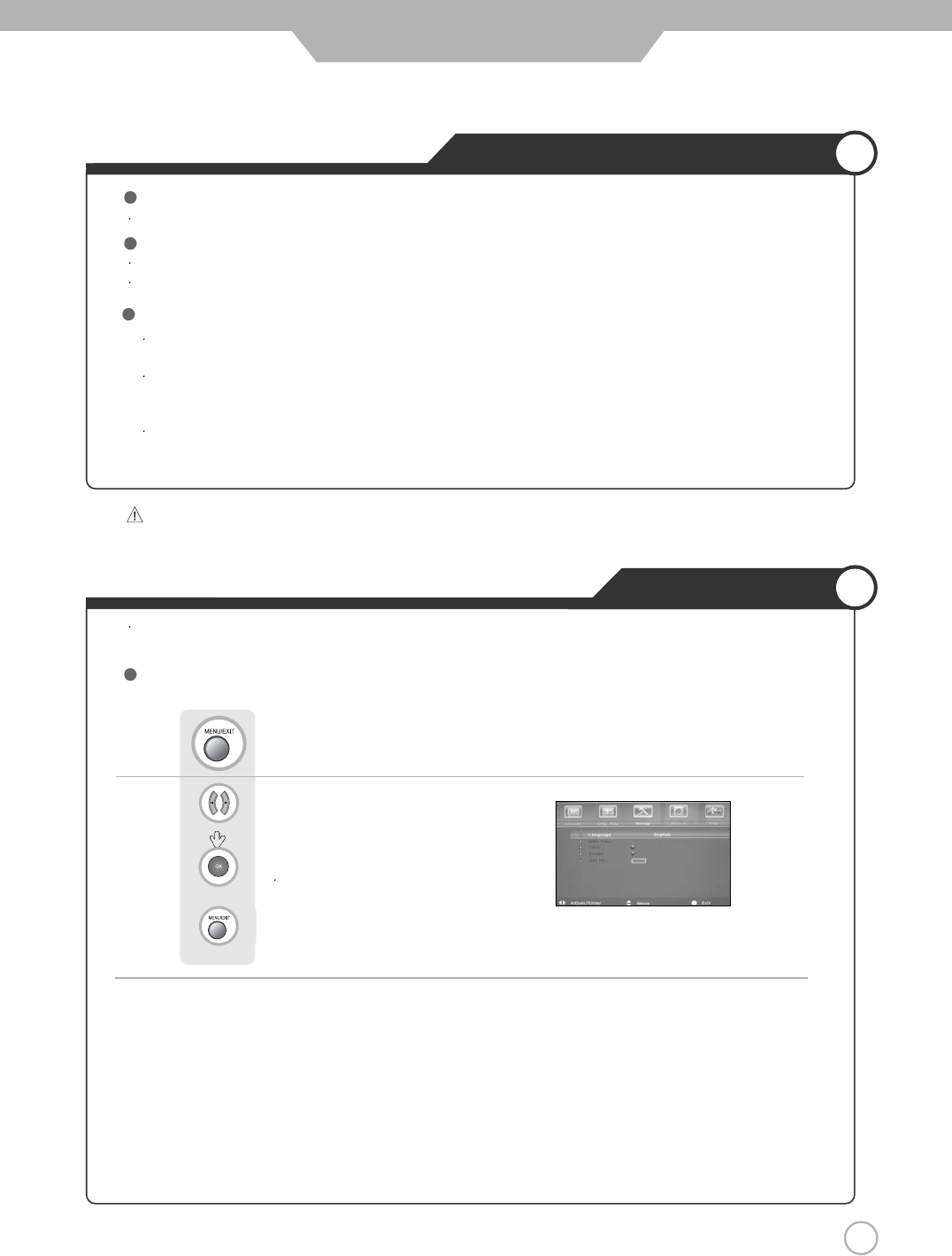
25
Basic Use
Prior to using the PDP Monitor.
Insert the power plug.
Connect external equipment properly.
Please use only after carefully reading this manual.
Check the power connection to the AC outlet and the connection of AC input to the PDP Monitor.
CAUTION - After unplugging the power cord, please wait at least more than 3 seconds to connect
the power cord back on.
Power on/ off
To turn the PDP Monitor on :
Press the "Standby" button.
To turn the PDP Monitor off :
Press "Standby" button on the PDP Monitor.
If ON Time setting is set, the standby power should be ON.
To turn on/off by remote controller :
Press the Power button of remote controller (If the PDP Monitor is not turned on, check that the AC Power Cord
on the PDP Monitor main body is connected. The standby power indicator will light up red if turned on).
Powering the PDP Monitor
Initial Settings
When the brand new television set it turned on for the first time, following settings can be set using the plug
and play function of the TV.
Using the menu
Use to move to the desired "Language".
Press to select.
the desived Language
Press to go back to the previous menu.
Press .
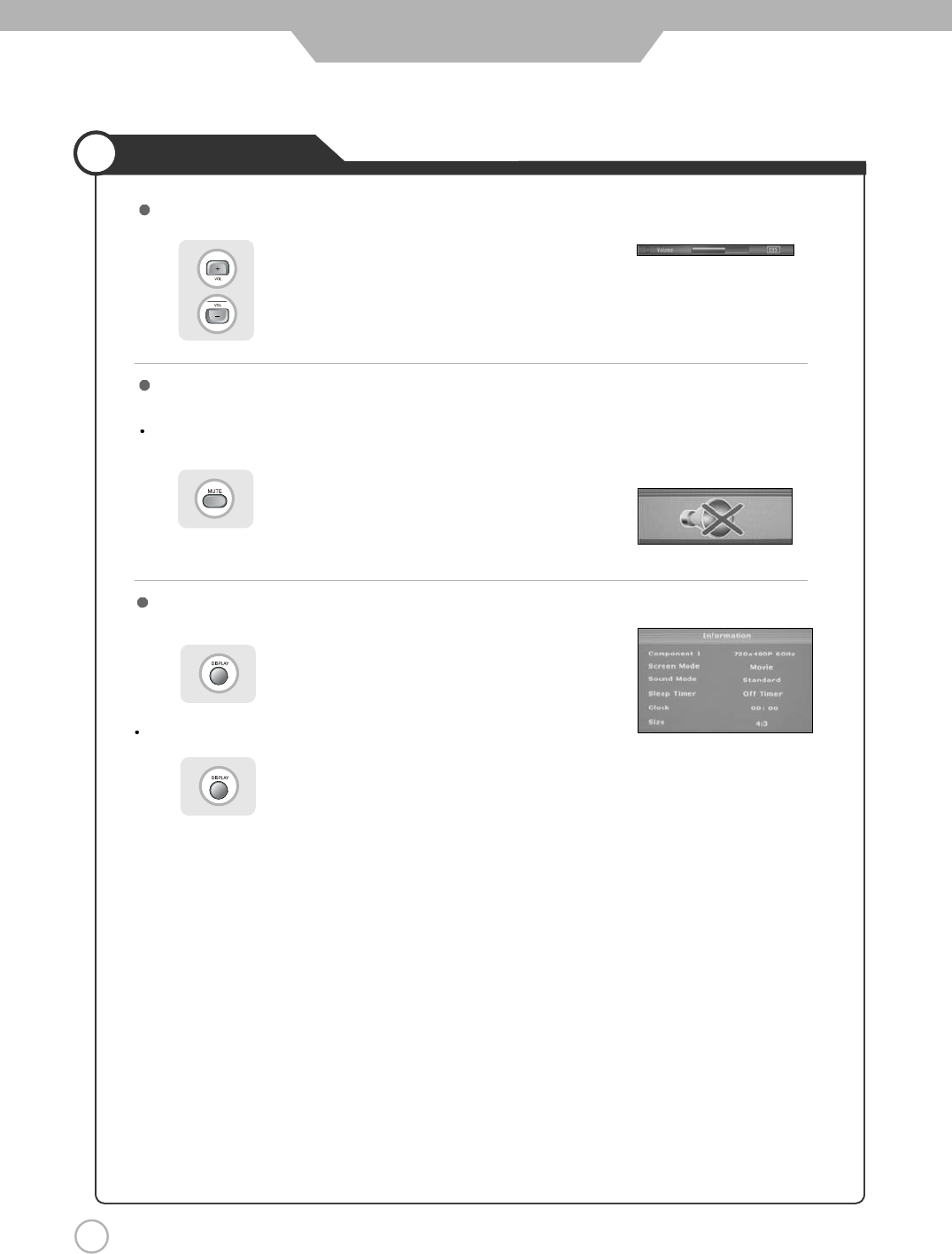
26
Press button on the remote control.
Press button or wait 4 seconds for the display to disappear.
Basic Use
INFO - To check the current state
To turn off only sound
Volume Control
Use the mute function to turn off the PDP Monitor sound for a while, when a phone or a bell rings.
Press button again to hear the sound again.
Display shows user's setting and selections.
increases the volume.
decreases the volume.
Watching TV
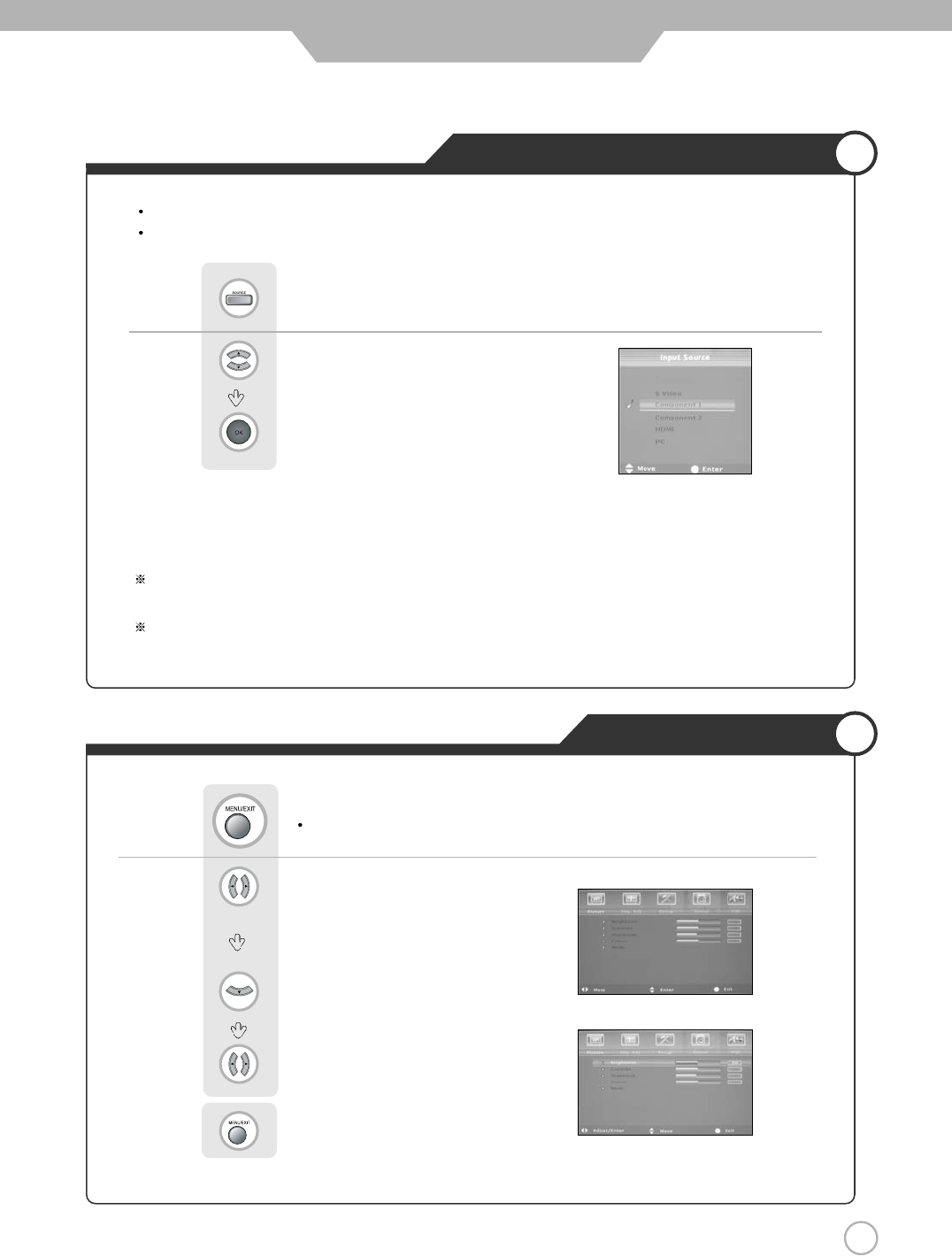
27
Selecting TV/External Input
Using the Menu
Use to move to the desired item.
Press to select.
Use (left, right arrows) to move the cursor
to the desired function.
Press to get into the sub menu.
Press to adjust the setting.
Basic Use
You can connect, Composite, S-Video, Component1/2,
PC and HDMI to the TV set and enjoy these functions.
All input sources will be automatically detected and displayed on screen.
PressPress
You can between the TV signal and the input signal of other appliances connected to the TV.
Use this function to switch to the input source you wish to view.
Press The menu screen will appear.
Press to go back to the previous menu.
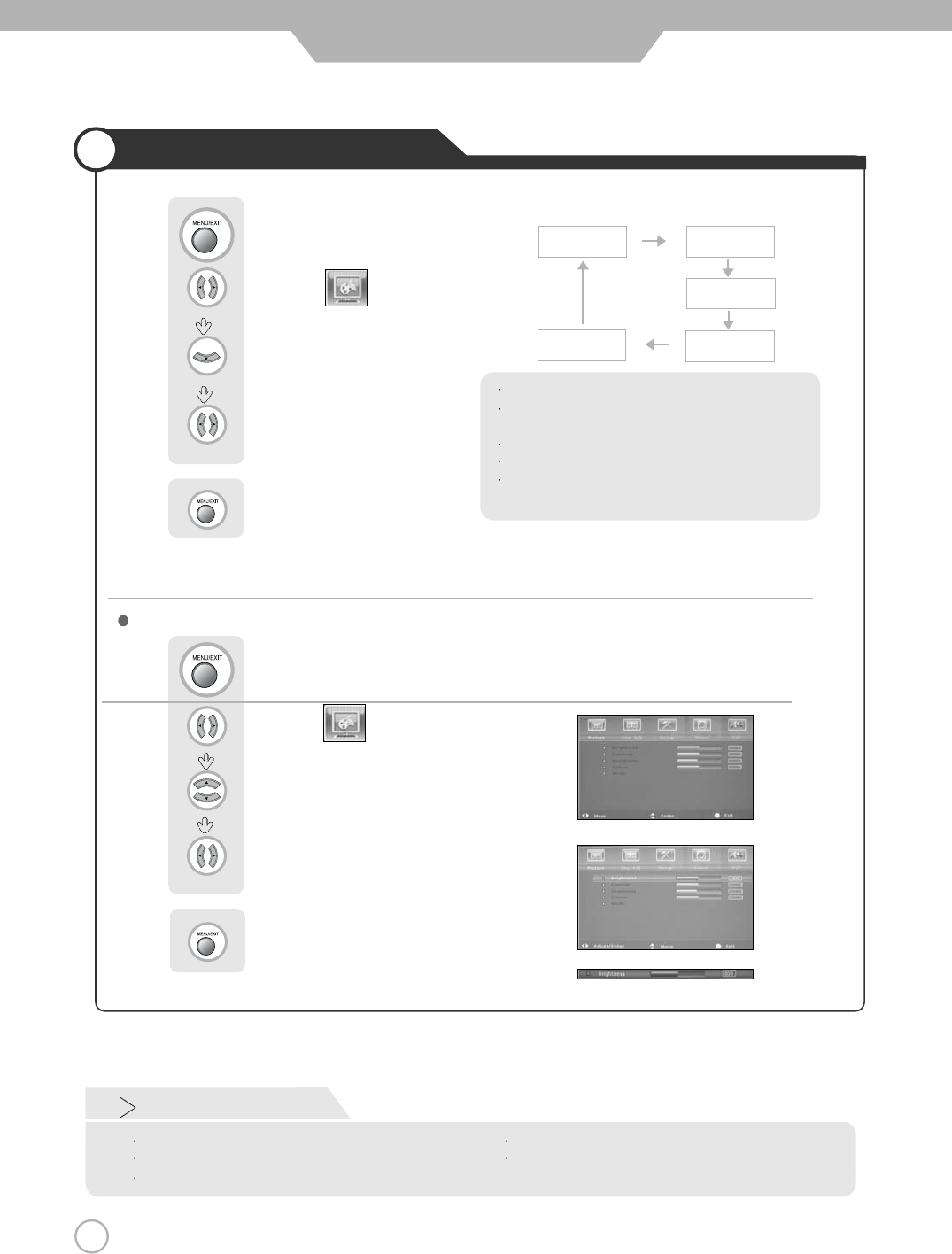
28
Use select between Custom/ Dynamic/
Standard/ Move/ Mild.
Press to go back to the previous menu.
Use to move to .
Press to move to "Mode".
Use to move to .
Use select between Brightness/ Contrast/
Colour/ Sharpness/Tint.
Use to adjust the setting.
Press to go back to the previous menu.
Basic Use
Press .
Custom Picture Adjustment
Custom : Select to set user's preferences.
Dynamic : Select when using the PDP Monitor in a
brightly lit environment.
Standard : It is the best screen setting.
Movie : Select when watching a movie.
Mild : Select when using the PDP Monitor in a dimly
lit environment.
Custom Dynamic
Standard
Movie
Mild
Press .
Custom Mode
Brightness : It adjusts the brightness of the image.
Contrast : It adjusts the contrast of image.
Tint : It adjusts the natural tint of the image. (This mode appears only NTSC Video format connected.)
Colour : It adjusts the intensity of the colour.
Sharpness : It adjusts the clarity of the image.
Changing Picture Settings
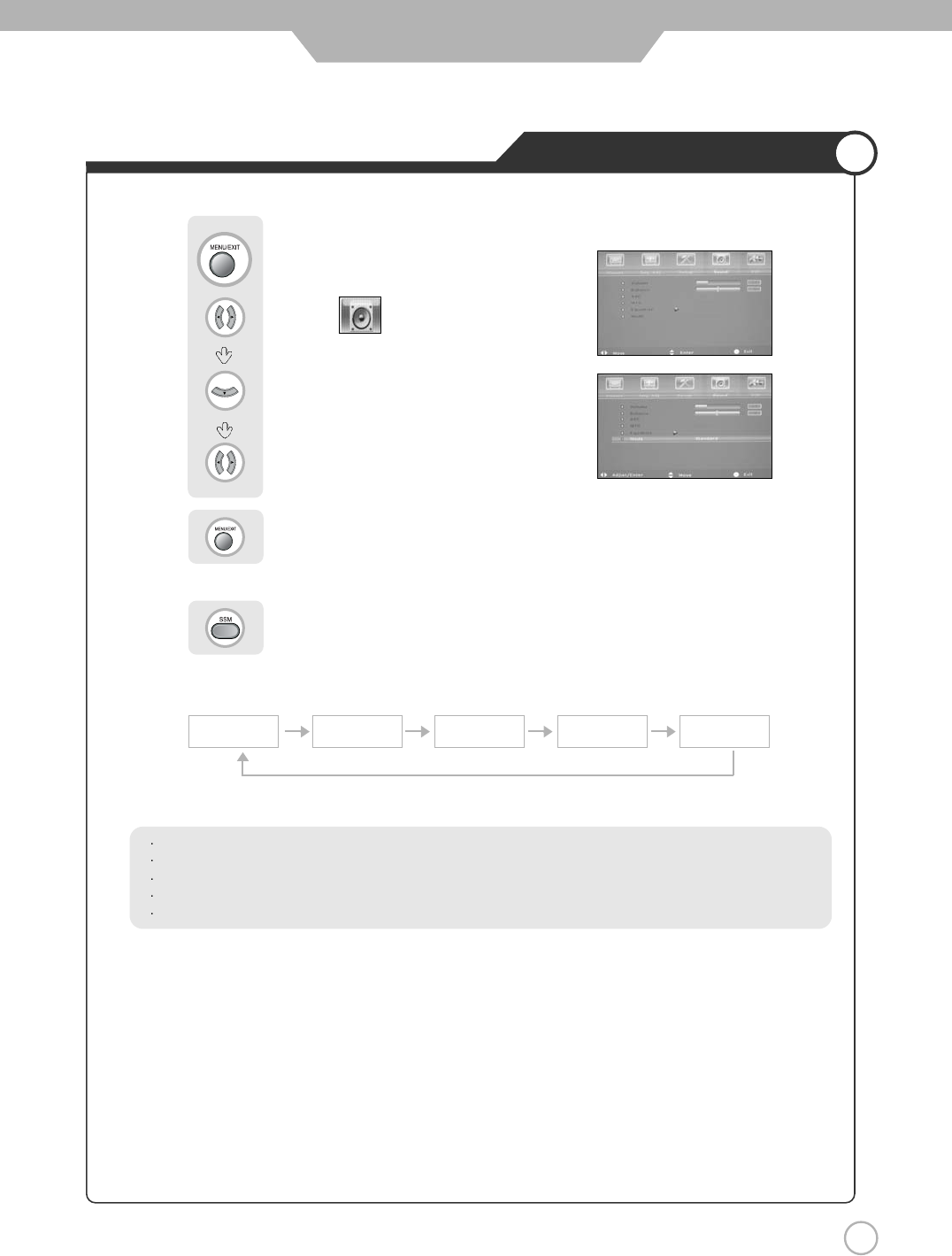
29
Changing Sound Settings
Use to move to .
Press to move to " Mode".
Use select between Custom,
Standard
,
Music, Movie, Speech.
Basic Use
Press to go back to the previous menu.
Press
or
Press .
Custom Standard Movie Music Speech
Standard : It is the flat sound setting with no equalizer effect at all.
Music : It is preset for music listening.
Movie : It is preset sound for watching a movie.
Speech : It is preset for hearing vocal audio clearly.
Custom : Select when listening to the sound to user's preference.
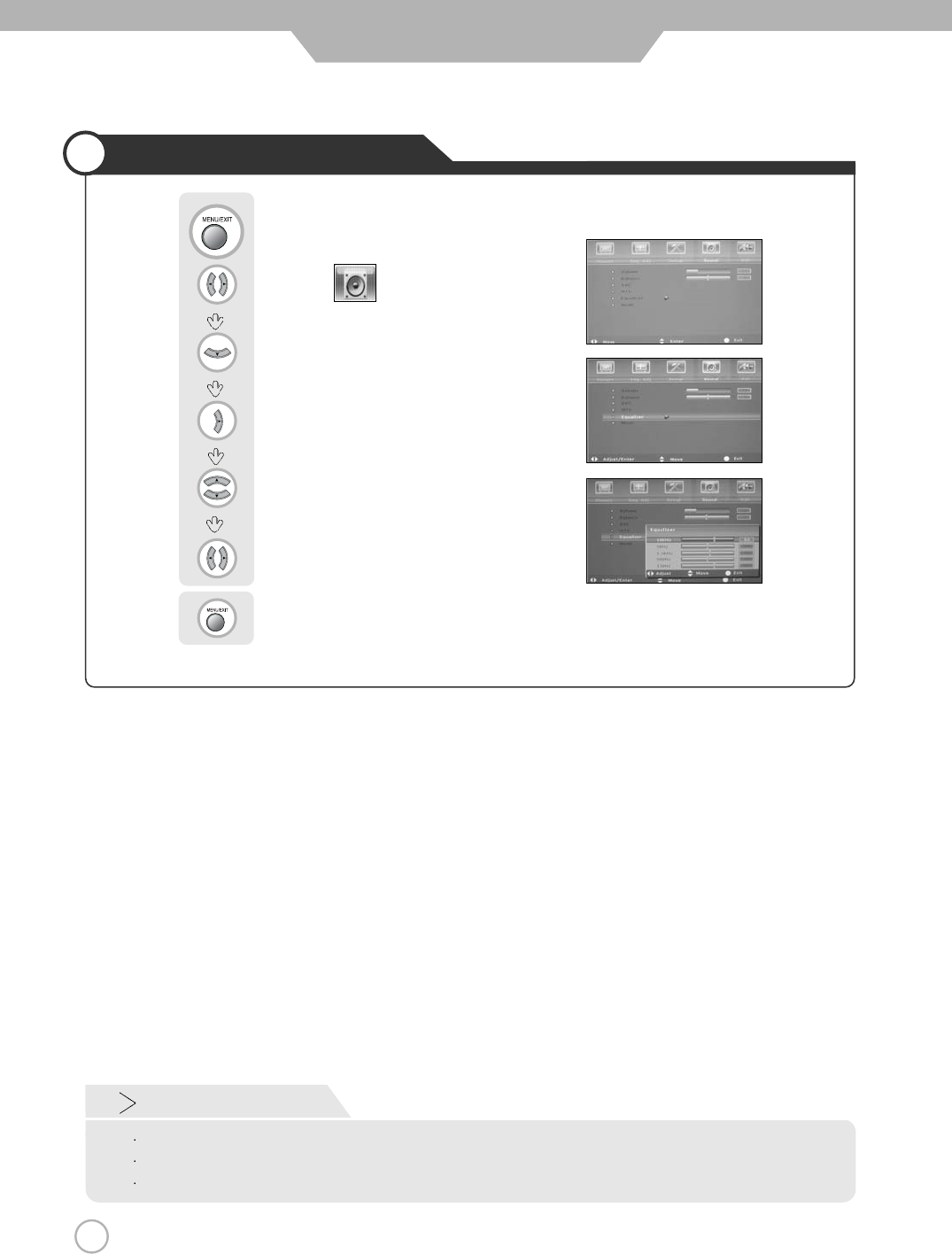
30
Use to move to the desired category.
Use to adjust the setting.
Press to go back to the previous menu.
Use to move to .
Press to move to " Equalizer".
Press to select.
Basic Use
Press .
Custom Mode
Volume : It adjusts the sound volume.
Balance : It adjusts the volume of speakers on the left and the right.
Equalizer : It adjusts the volume by frequency bands and the user can select the desired sound quality.
Custom Sound Adjustment
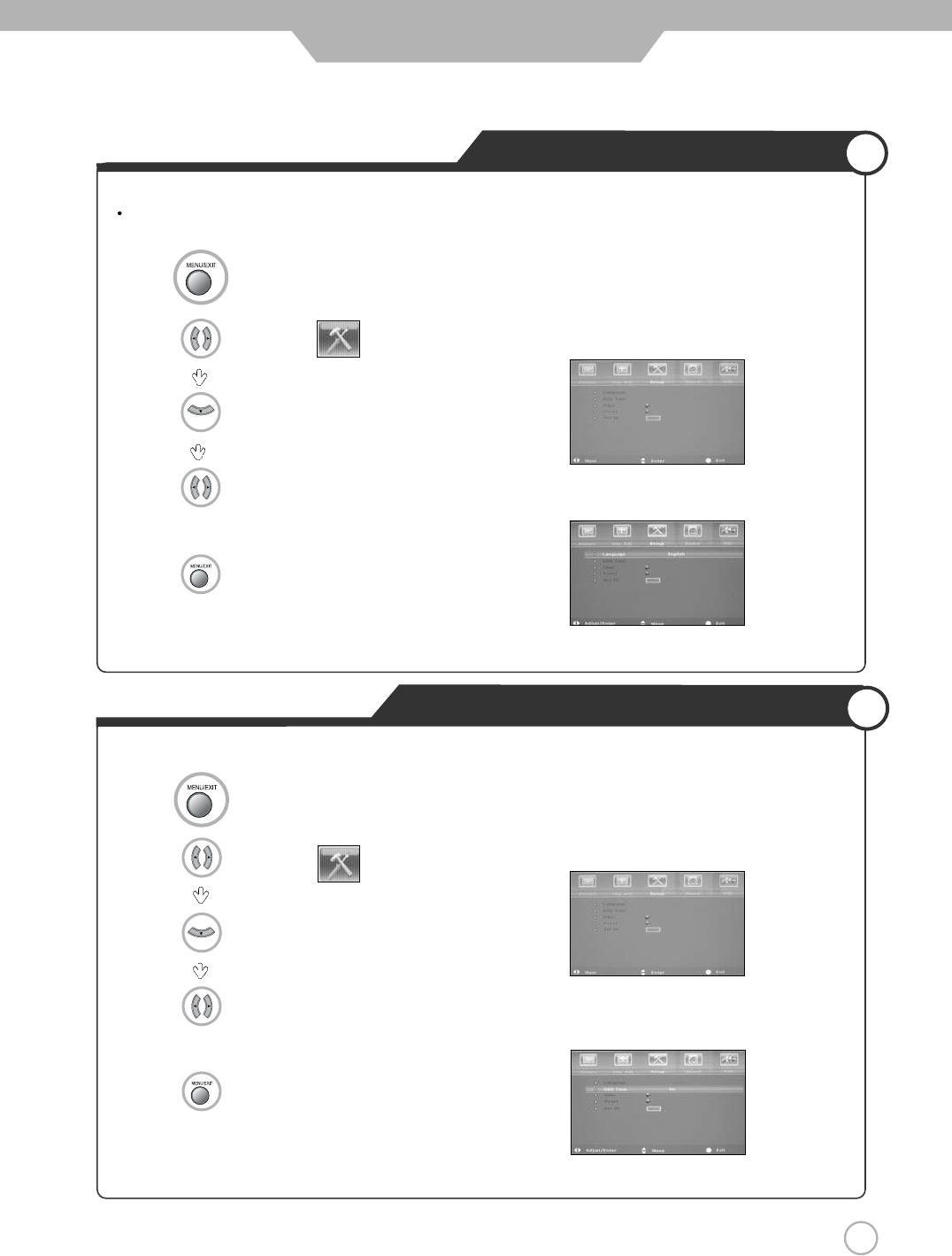
31
Press to go back to the previous menu.
Use to move to .
Press to move to "OSD Tone".
Use to select the "On" or "Off".
Press to go back to the previous menu.
Use to move to .
Press to move to "Language".
Use to select the desired language.
Basic Use
Menu screen can be viewed in the language preferred by the user.
Press .
Press .
Selecting the Menu Language
Setting OSD Tone Menu Background
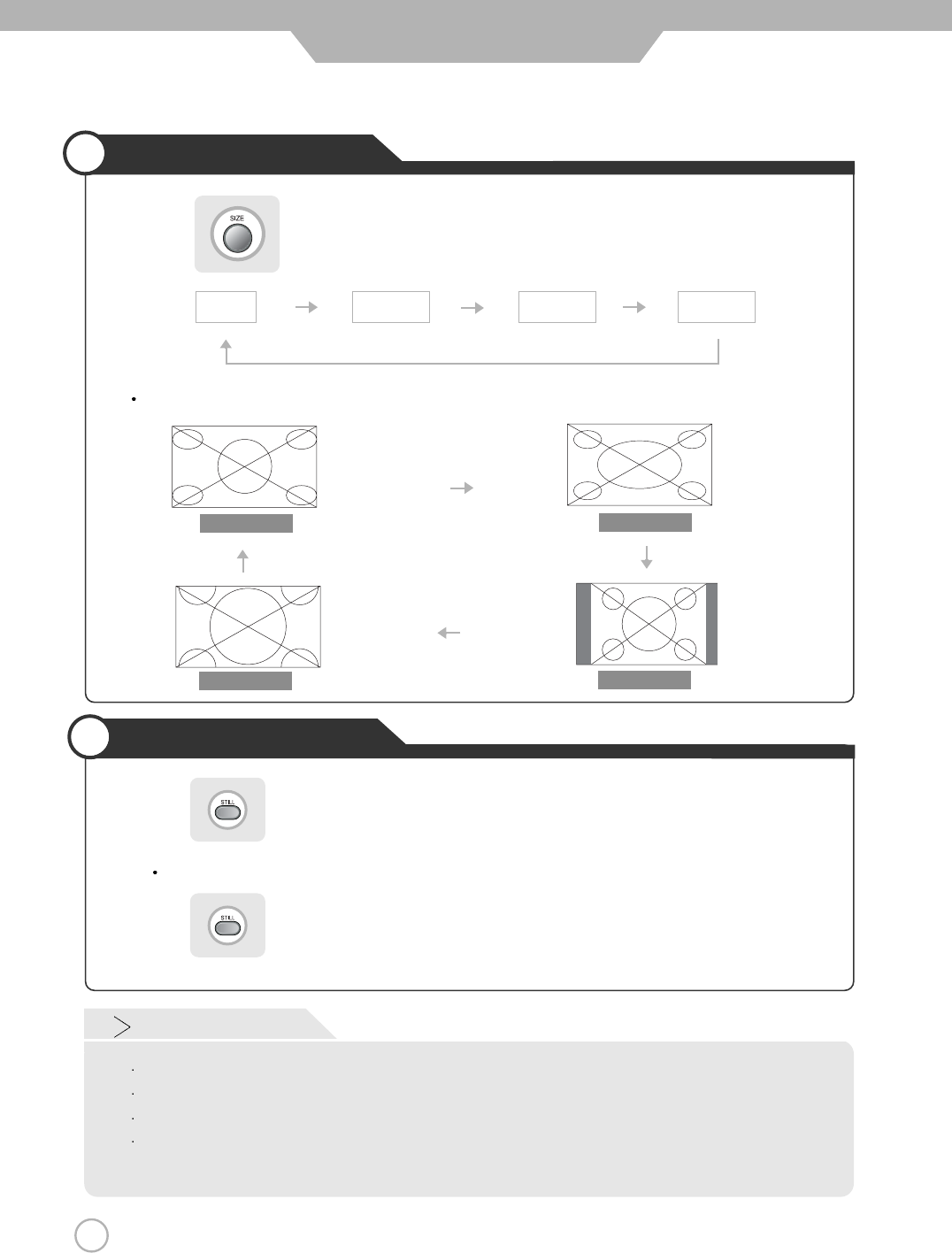
32
Application
Press .
Screen Size
wide - It makes 16 : 9 format for input signal.
Panorama - It makes 4 : 3 format fit into 16 : 9 format with minimal loss in content.
Zoom - It enlarges the natural screen factor by approx. 5 %
4 : 3 - It is the standard format of broadcasting.
wide
4 : 3
Zoom
Panorama
wide
4 : 3
Zoom Panorama
In PC input mode, you can only select either the wide or the 4 : 3 mode.
Press .
Picture will freeze, but sound will continue to be heard.
Press again to cancel.
Changing Screen Size
To view the still picture
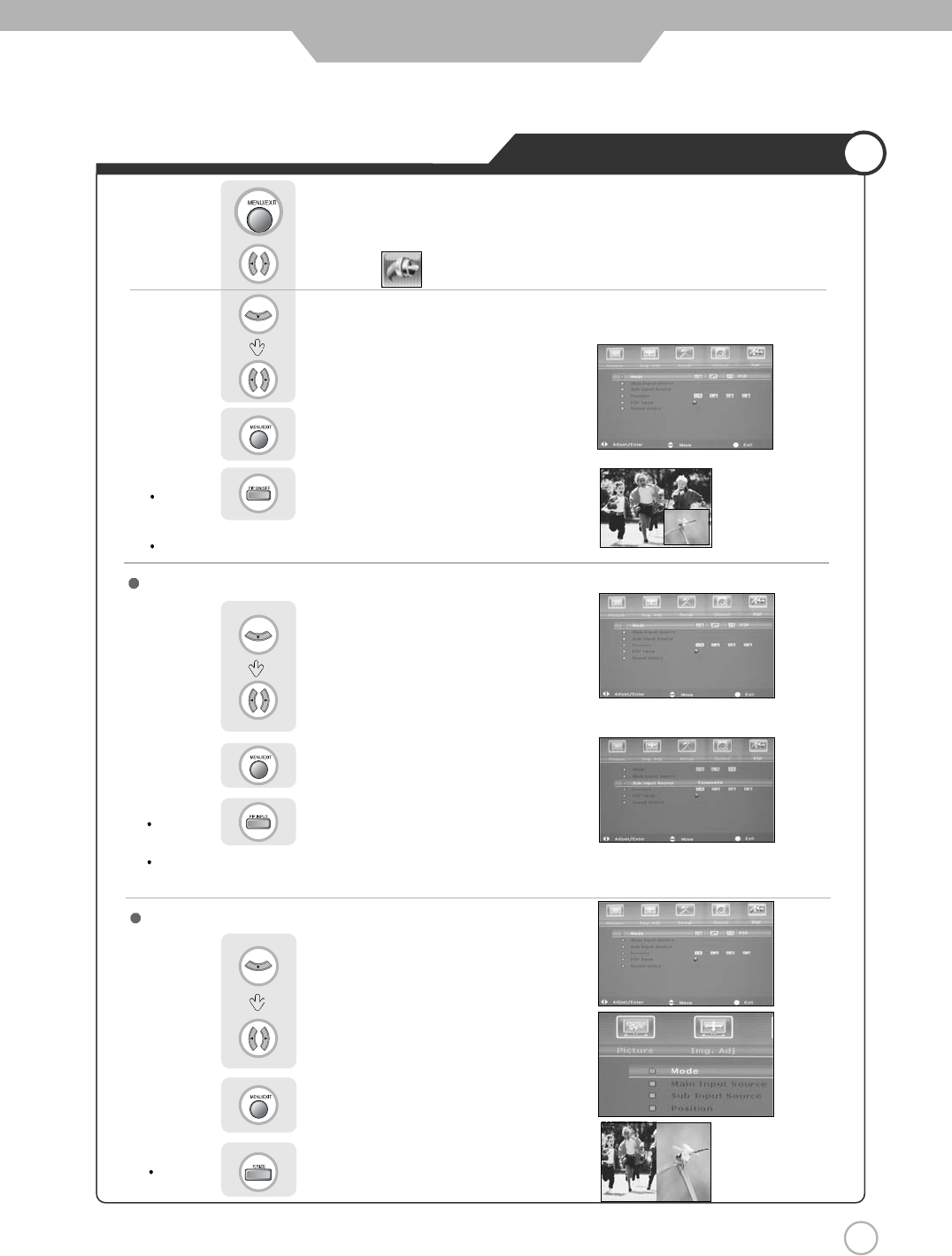
33
Application
Use to select the desired input source.
Press to go back to the previous menu.
Press to move to "Mode".
Use to select the “PIP” or “PBP”.
Press to go back to the previous menu.
Press to move to "Sub Input Source"
Use to select the "PIP".
Press to go back to the previous menu.
Use to move to .
Press to move to "Mode".
Press .
Or press .
The sub-screen can be changed to display picture from
the desired input source
.
Or press .
Sound from only one of the screens may be heard.
Or press .
External Input
Changing the Screen Size
Viewing Picture in Picture
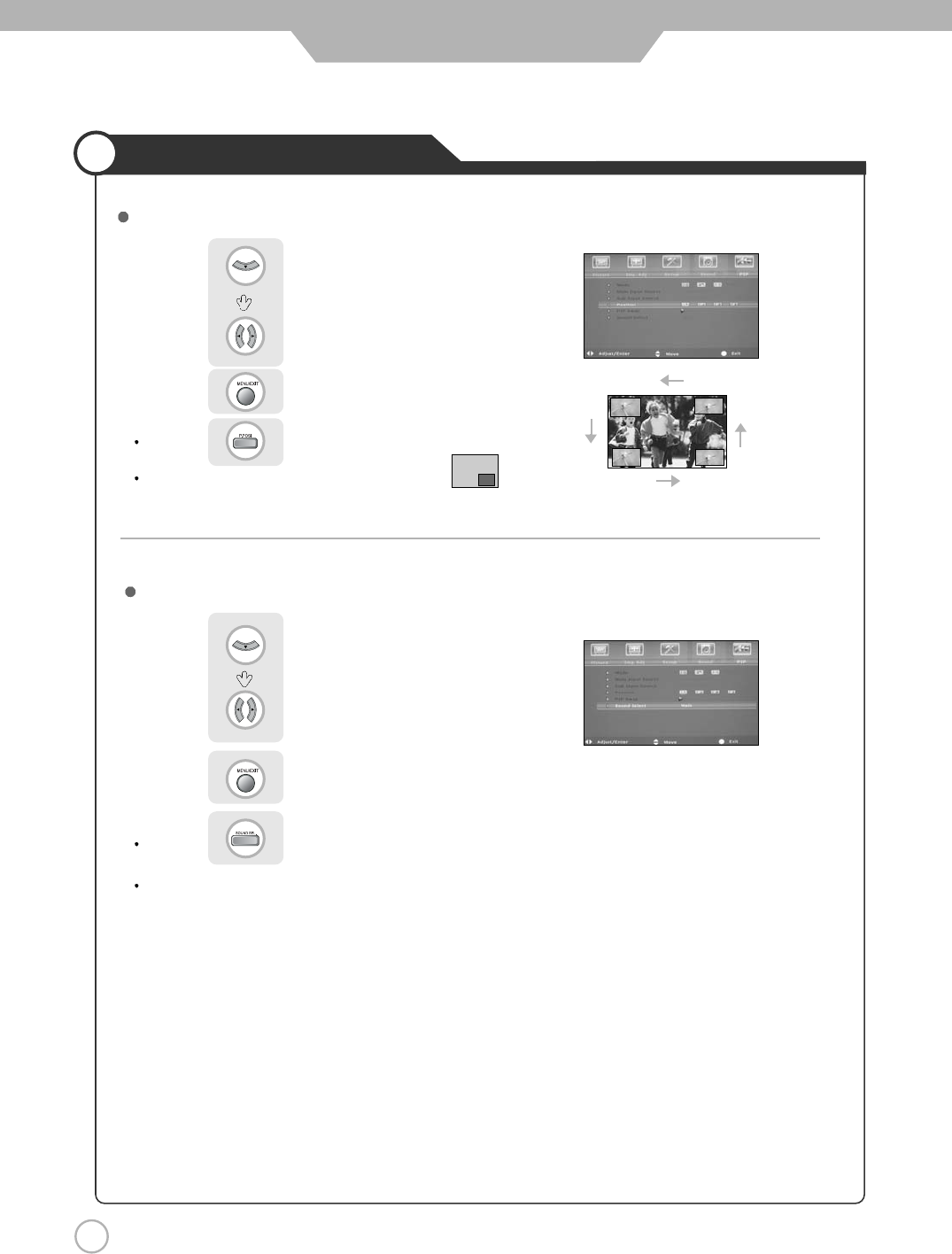
34
Viewing Picture in Picture
Application
Selecting Sub Screen Sound
Or press
The sound of the sub screen can be selected when PIP is being displayed.
Use to select the desired position.
Press to go back to the previous menu.
Press to move to "Position".
Selecting Position
Or press .
Sub-screen position can be selected only from the .
Press to move to "Sound Select".
Use to select the "Main" or "Sub".
Press to go back to the previous menu.
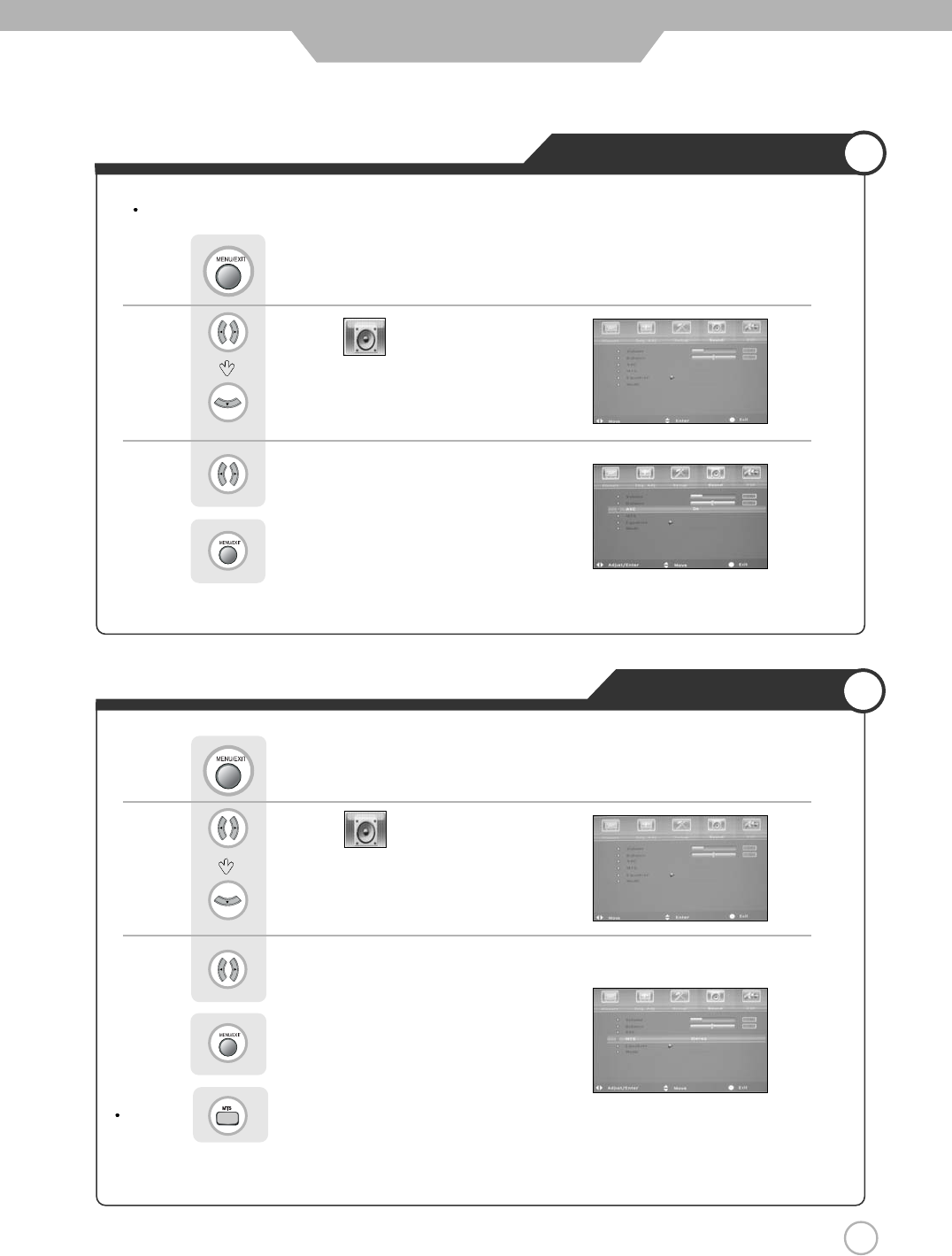
35
Press to go back to the previous menu.
Use to move to .
Press to move to "MTS".
Use to select the desired category.
Use to select the "On" or "Off".
Press to go back to the previous menu.
Use to move to .
Press to move to "AVC".
Application
This feature maintains an equal Volume level ; even if you change channels.
Or press . (Multi Television Sound)
Press .
Press .
Auto Volume Control
Stereo Settings
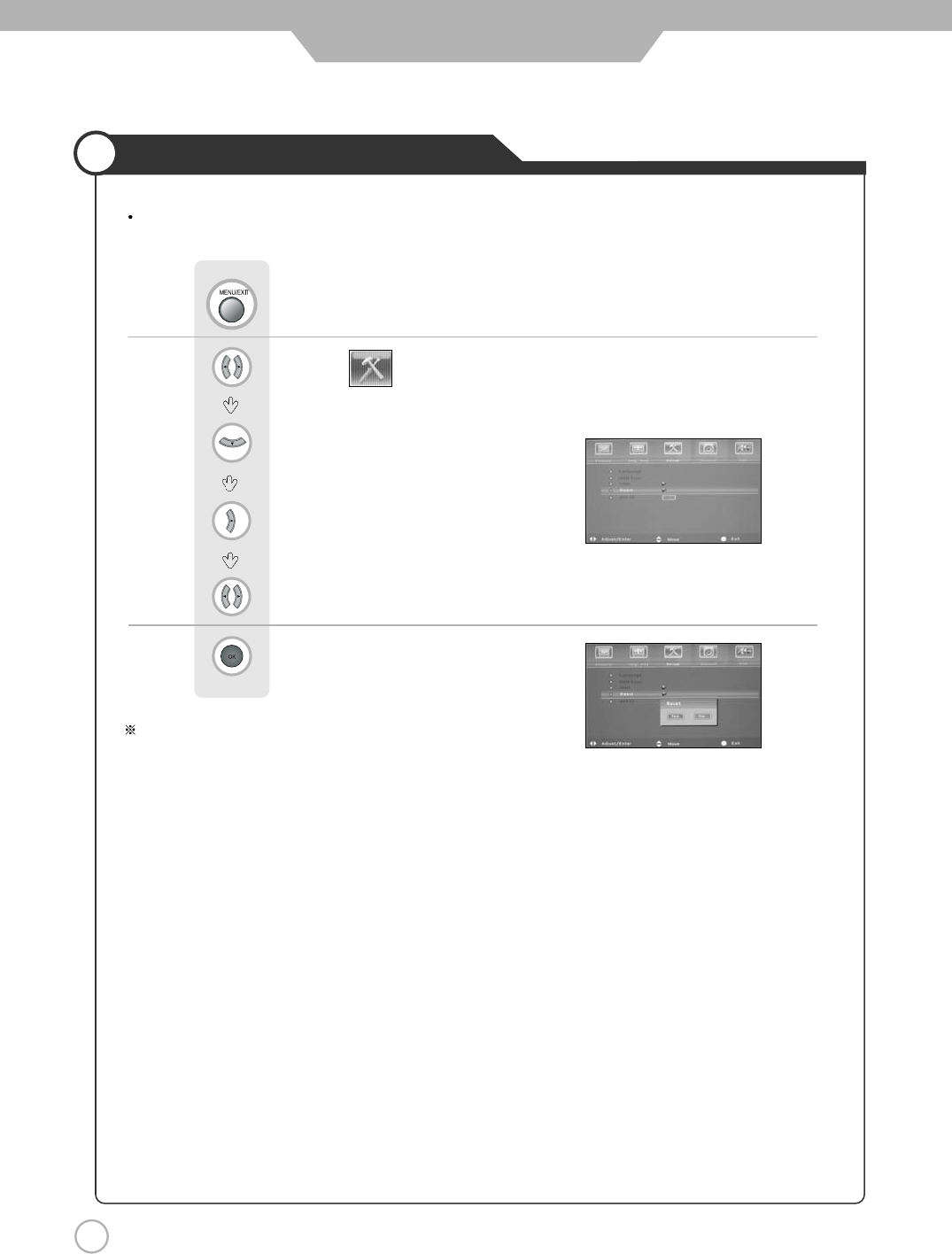
36
Application
Use to move to .
Press to move to "Reset".
Press to select.
Use to select the "Yes" or “No”.
Press to select.
Resetting PDP Monitor Settings
It resets all of the parameters to the factory default.
The PDP Monitor will turn off. The parameters will be set to factory default.
Press .
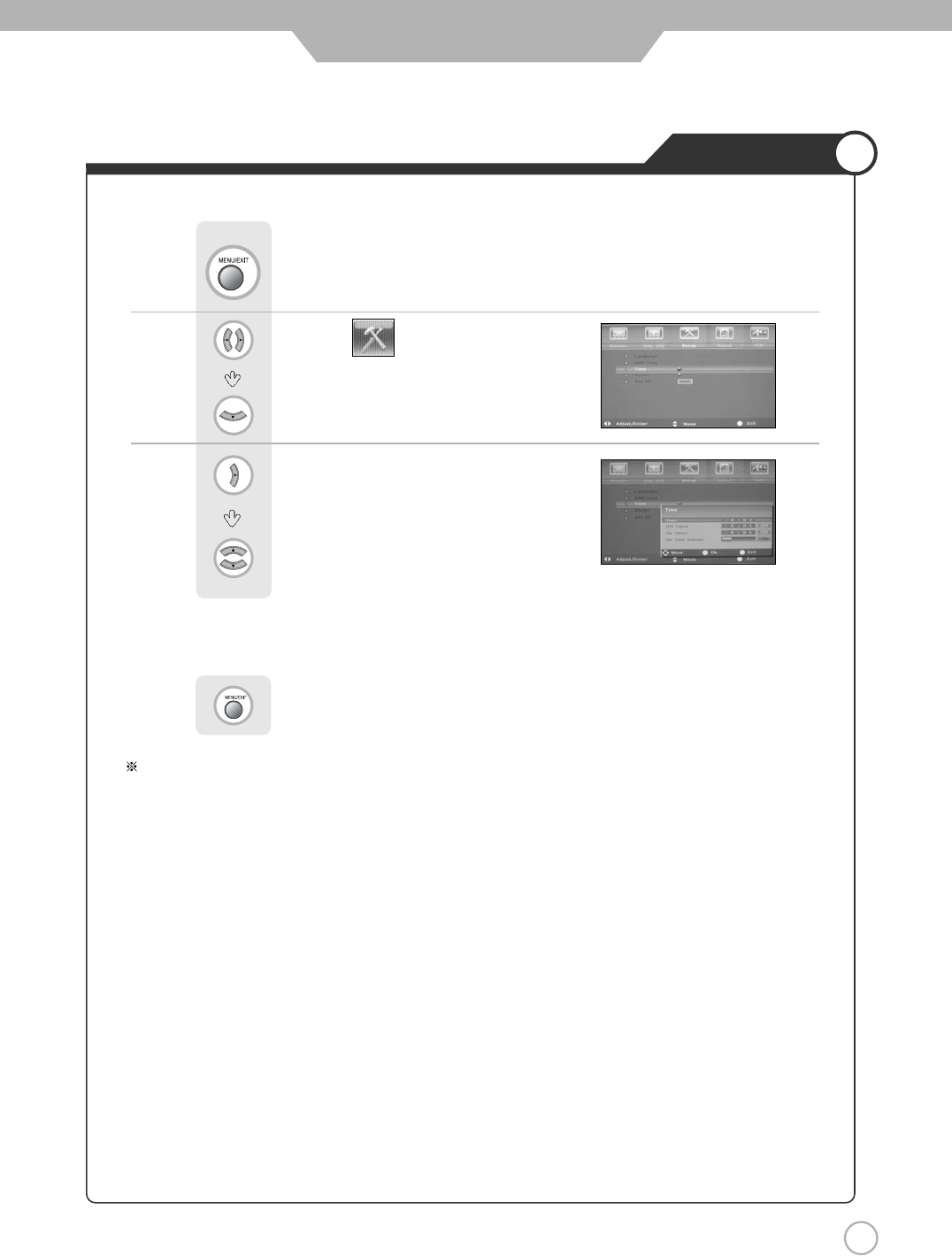
37
Application
Use to move to .
Press to move to "Time".
Press to select.
Use to move to “time”.
Use digit key to adjust the desired hour and minute.
Press to go back to the previous menu.
Setting Time
Press .
You can set your local time by adjusting the differences from GMT, according to your location.
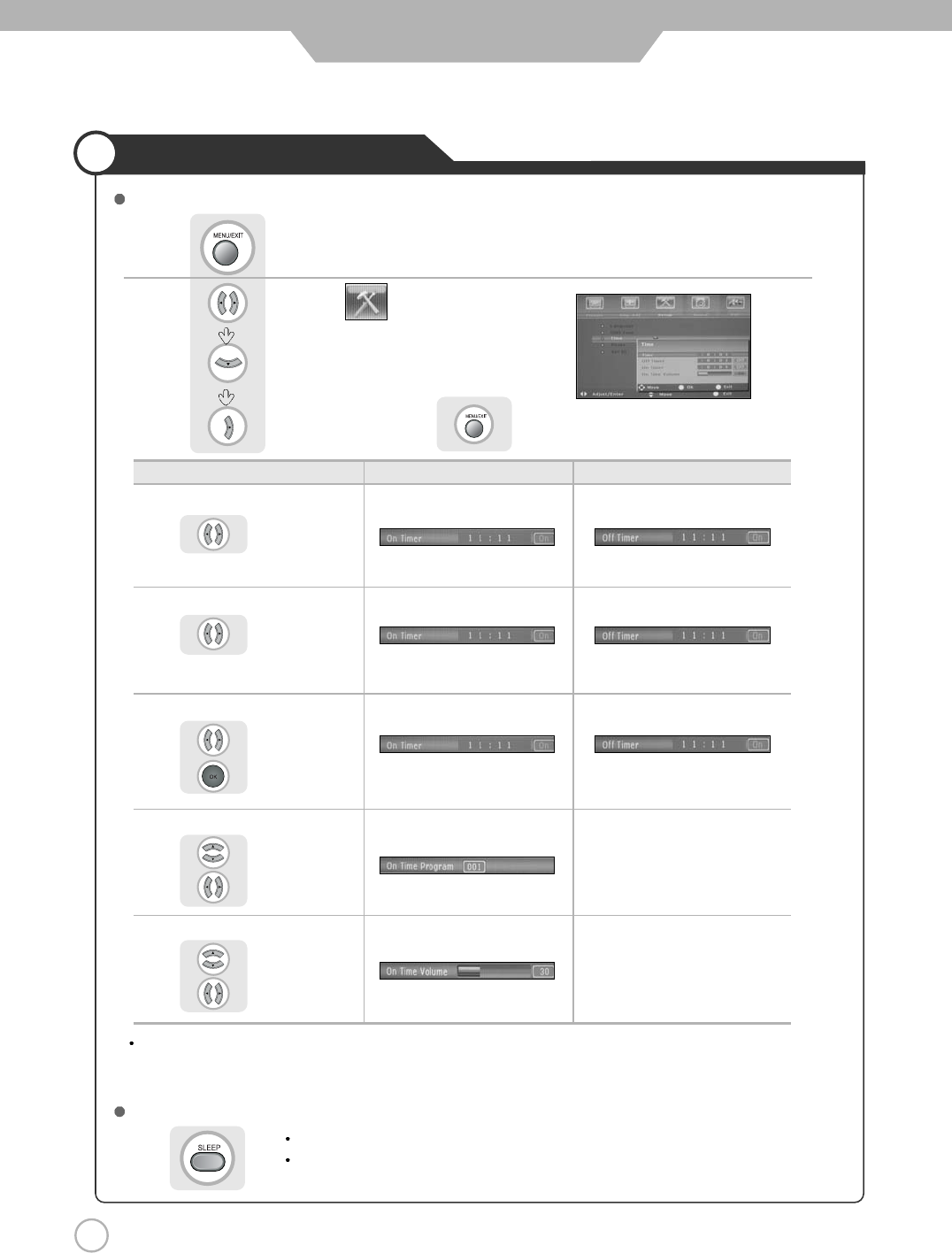
38
Automatic Power On/Off
Application
Setting Time for Power On Setting Time for Power Off
Setting Hour
Use to select,
digit key to set
Setting Minute
Use to select,
digit key to set
Set/Cancel
Use to select,
to select the
"On" or "Off"
Channel Select
Use to select,
to set program
Volume Control
Use to select,
to set volume
It automatically turns off the
Monitor
after a designated period of time
Depending on the number of times the "Sleep" button is pressed, the
Monitor
will be
turned off after 30, 60, 90, 120, 150 or 180 minutes.
It sets the current time and then the automatic turn on/off can be set. The time settings are retained only
if the AC Power Cord is unplugged, the time is reset. To retain the time setting, do not unplug the AC
Power Cord.
To have the Monitor turn off after you fall a sleep
Clock time must be set
Press .
Press .
Use to move to .
Press to move to “Time”.
Press to select. Press to go back to the previous menu.
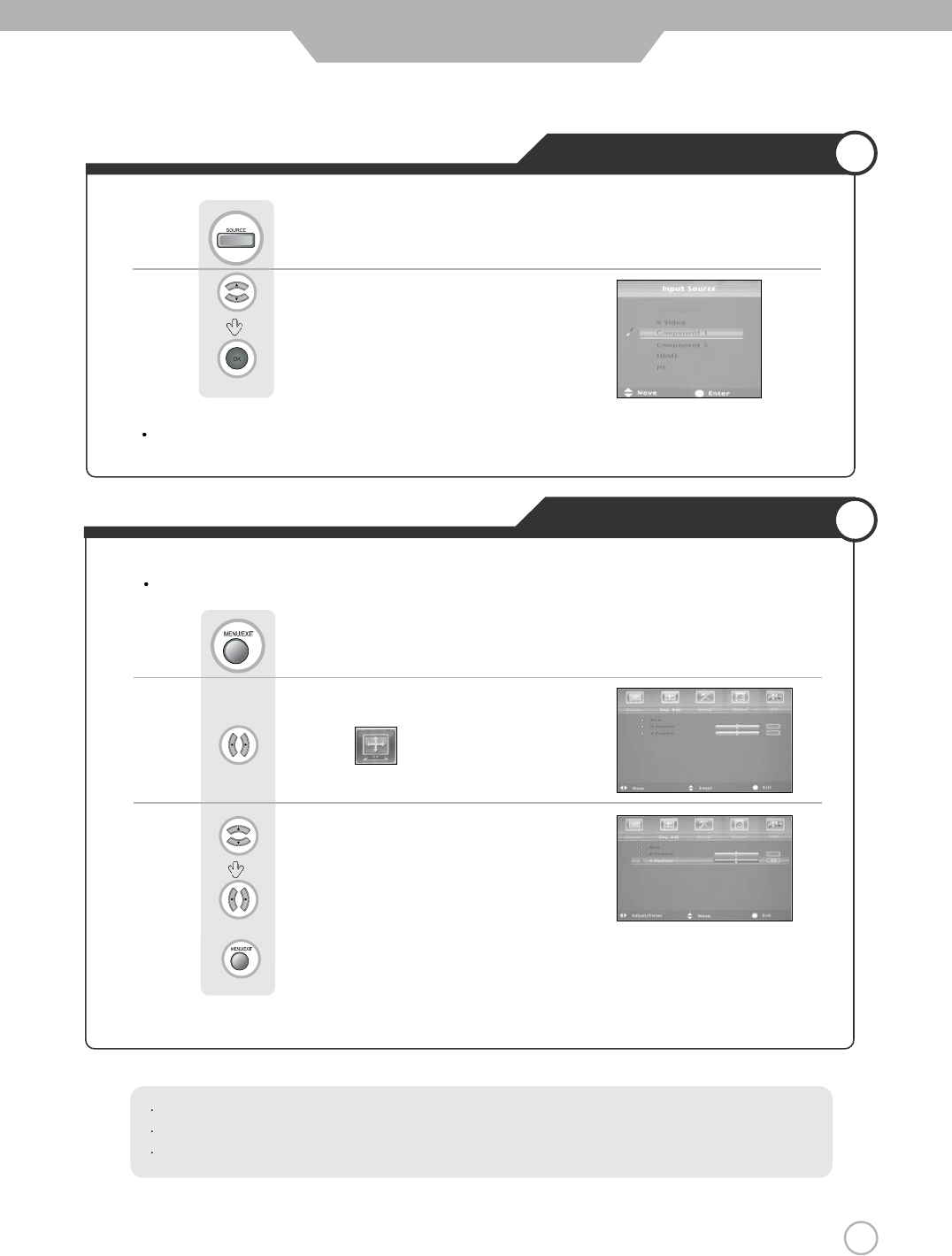
39
Use to move to "PC".
Press to select.
Use to move to .
Use to move to desired category.
Use to adjust the setting.
Press to go back to the previous menu.
PC Mode must be on in order for you to use the TV as a monitor.
Using TV as a Monitor
Press .
Use this function to remove or reduce noise impacts in case TV vibrates and image boundary is unstable
Press .
Auto : Use when the screen is not focused or centered.
H-Position : It moves the image on the screen horizontally.
V-Position : It moves the image on the screen vertically.
Using TV as a Monitor
Adjusting PC Screen
Monitor
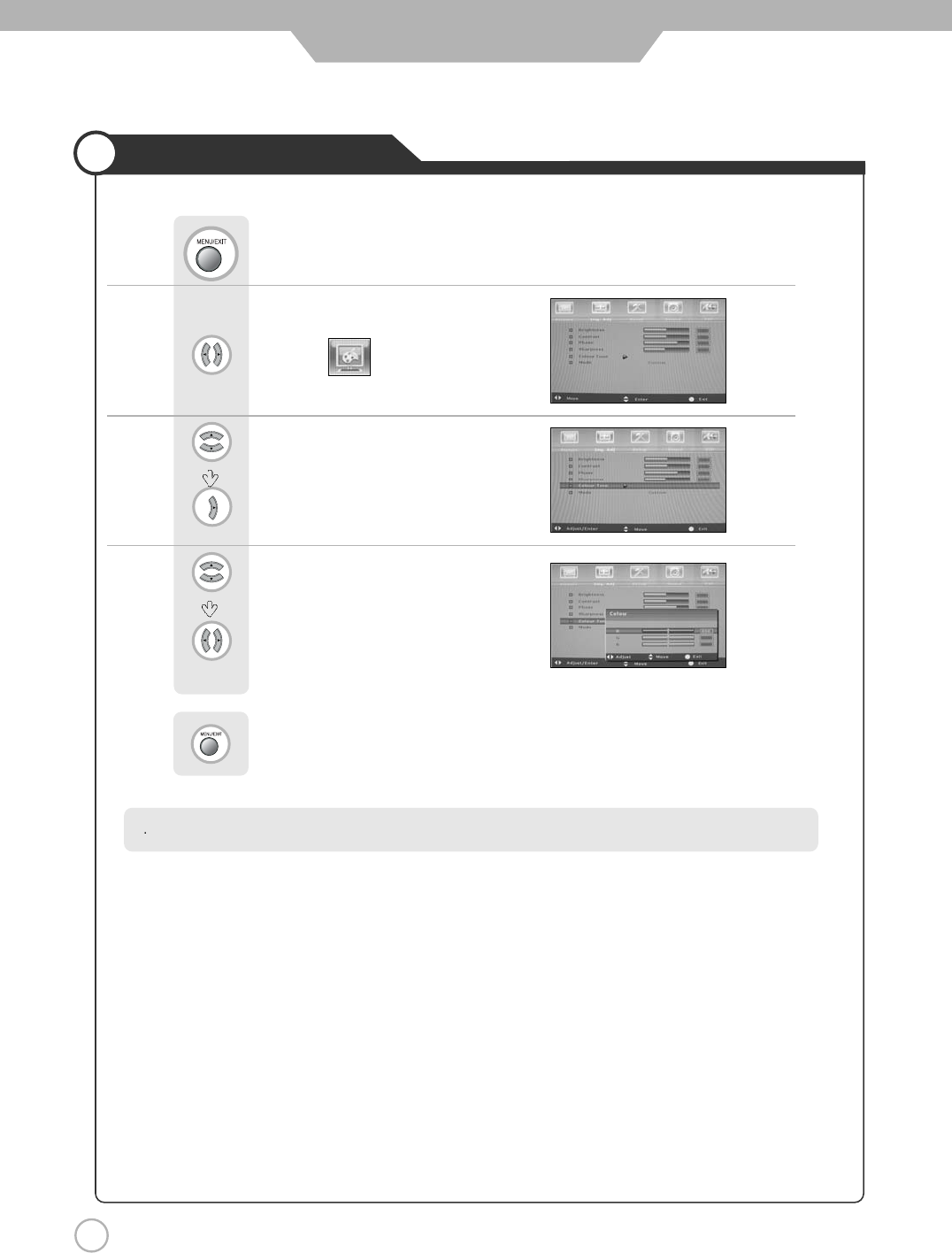
40
Adjusting Colour Tone
Monitor
Use to move to .
Use to move to "Colour Tone"
Press to select.
Use to select the desired category.
Use to adjust the setting.
Press to go back to the previous menu.
Press .
Phase : It adjusts the phase shift of the image. Use when image appears blurry or out of focus.
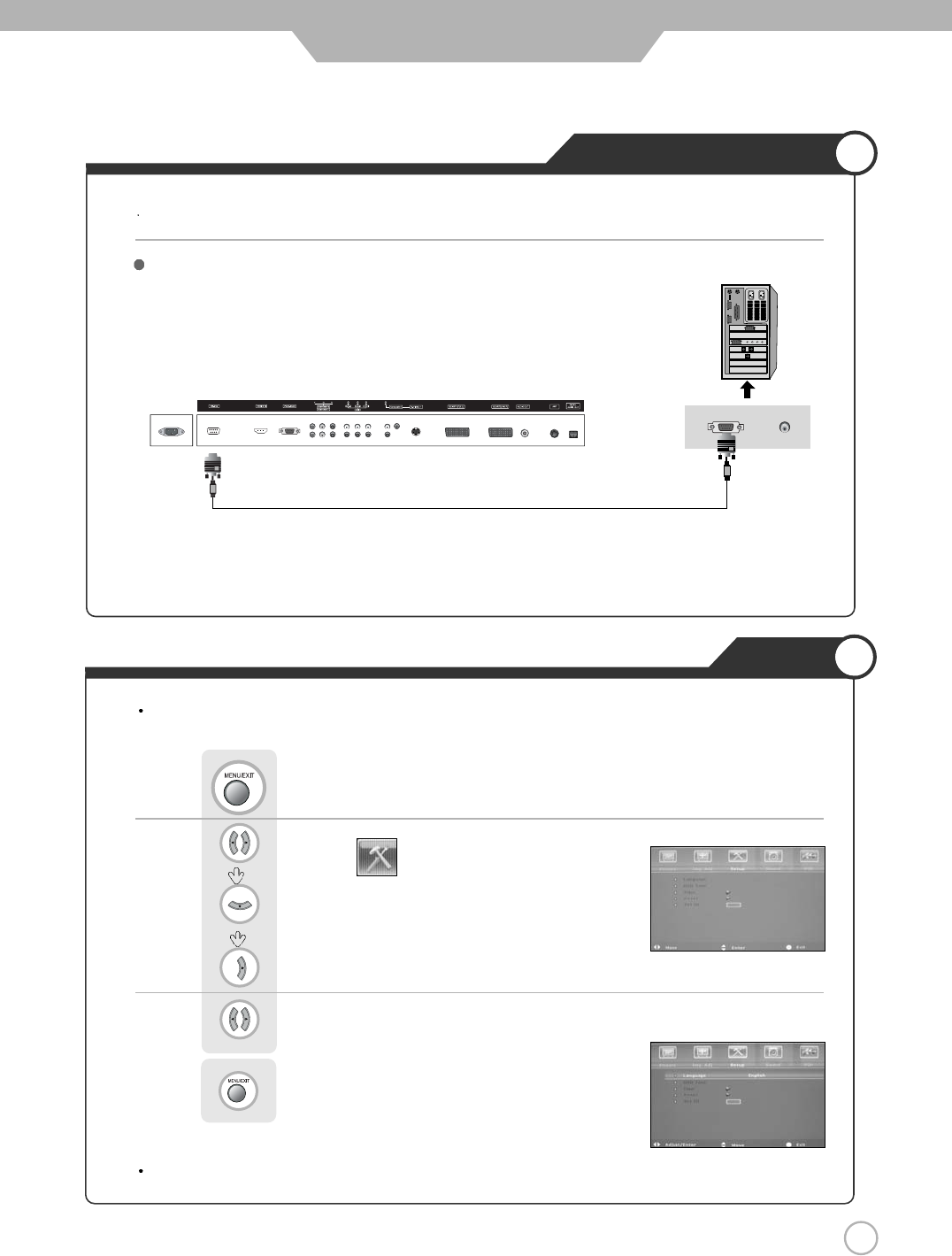
41
External adjustment
External adjustment
Set ID
How connect a external equipment
Use the RS-232C jack o control monitor’s functions externally by external equipment.
<Back view of the PDP Monitor>
The adjustment range of Set ID is 1~99.
Use this function to choose monitor ID number.
Use to move to .
Press to move to "Set ID".
Press to select.
Use to select the desired ID number.
Press to go back to the previous menu.
Press .
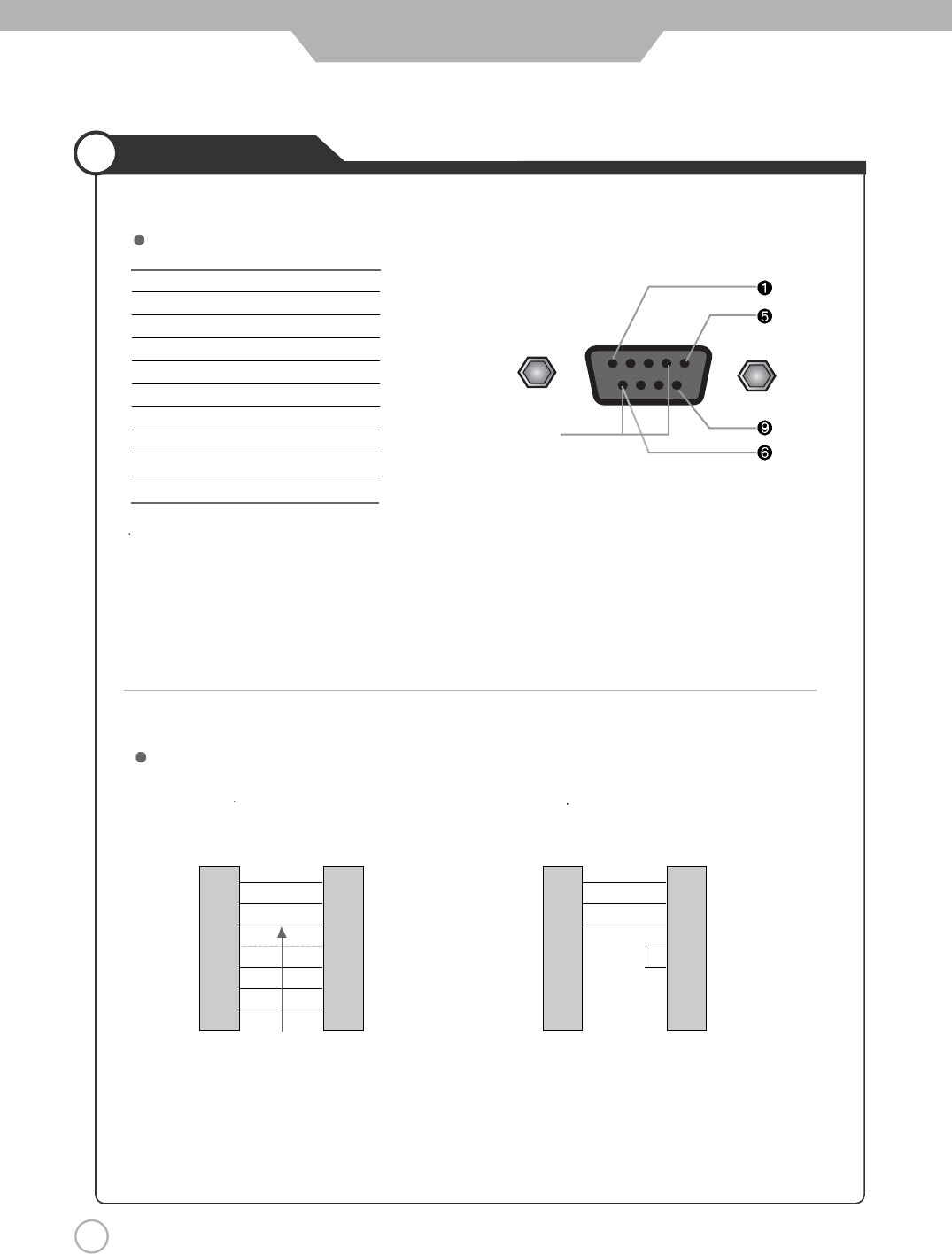
42
External adjustment
Special features
Pin NO.4 and Pin
NO.6 must be
connected on
monitor side
Use a crossed (reverse) cable.
Wire the cable so that each pair of data lines cross between the two devices. These data line pairs are RXD
(Receive to send) and TXD (Transmit data), DTR (DTE side ready) and DSR (DCE side ready), and RTS
(Ready to send) and CTS (Clear to send).
PC PDP Monitor
D-sub 9 D-sub 9
7-wire configuration
(Standard RS-232C cable) 3-wire configuration
(Not standard)
No. Pin name
1 No connection
2 RXD (Receive data)
3 TXD (Transmit data)
4 DTR (DTE side ready)
5 GND
6 DSR (Dce side ready)
7 RTS (Ready to send)
8 CTS (Clear to send)
9 No Connection
RXD 2 3 TXD
TXD 3 2 RXD
GND 5 5 GND
DTR 4 6 DSR
DSR 6 4 DTR
RTS 7 8 CTS
CTS 8 7 RTS
PC PDP Monitor
D-sub 9 D-sub 9
RXD 2 3 TXD
TXD 3 2 RXD
GND 5 5 GND
DTR 4 4 DTR
DSR 6 6 DSR
RTS 7 7 RTS
CTS 8 8 CTS
Type of connector : D-Sub 9-pin male
RS-232C configurations
Control line

43
External adjustment
RS232C Communication Protocol
BAUD RATE : 19200 bps
Data Length : 8bits
Parity : None
Stop bit : 1bit
Item ASCII Code Data(hex)
1. Power p 00h~01h
2. Input Source i 00h~07h
3. Aspect Ratio r 00h~08h
4. Volume Mute w 00h~01h
5. Volume Control v 00h~64h
6. Screen Mode s 00h~04h
7. Brightness b 00h~64h
8. Contrast k 00h~64h
Item ASCII Code Data(hex)
9. Information f 00h~01h
10. Pip On o 00h~01h
11. Pip Source u 00h~07h
12. Pip Location n 00h~03h
13. Pip Sound set e 00h~01h
14. Pip Mode d 00h~02h
15. Sound Mode y 00h~04h
* Transmission
{Command}{ }{SET ID}{ }{Data}{Cr}
{Commad} To Control Code PDP Monitor
{ } "Space , ASCII Code = 0x20"
{SET ID} You Can Adjust SET ID Setup
Menu of PDP Monitor
{Data} Data Command
Transmit 'FF' data to data
read mode
{Cr} Carriage Return
ASCII Code 0x0d
* Ok Acknowledge
{SET ID}{:}{OK}{x}{Data}{x}
The PDP Monitor set transmits ASCII based on
this format When receiving normal data. At this
time, If the data is data read mode, it indicates
present status data if the data is data write
mode, it returns the data of PC.
* In case set ID is 0, Ack data doesn’t feed back, and
you can adjust all PDP Monitor set.
COMMUICATION PARAMETERS
Command List
Tramsmission / Receiving Protocol List
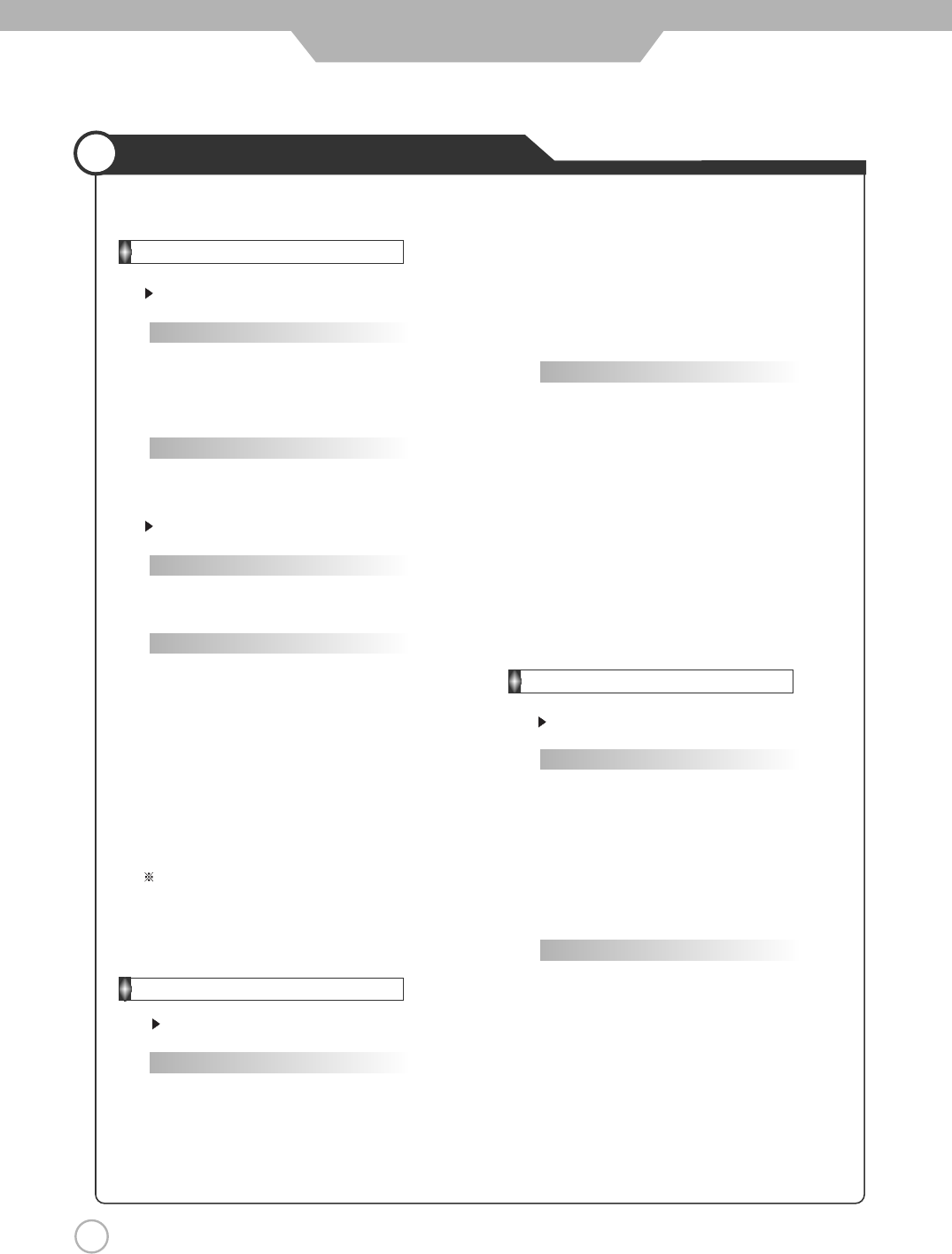
44
External adjustment
RS232C Communication Protocol
2. Input Source : i
To Input Source Select
* Transmission
{i}{ }{SET ID}{ }{Data}{Cr}
Data 0 : TV
Data 1 : Scart 1
Data 2 : Scart 2
Data 3 : Composite
Data 4 : S-Video
1. Power : p
To Control Power On/Off of the PDP Monitor
* Transmission
{p}{ }{SET ID}{ }{Data}{Cr}
Data 0 : Off
Data 1 : On
* Ack
{SET ID}{:}{OK}{x}{Data}{x}
Data 0 : Off
Data 1 : On
Read Power On Source Status
* Transmission
{p}{ }{SET ID}{ }{FF}{Cr}
* Ack
{SET ID}{:}{OK}{x}{Data}{x}
Data 0 : TV
Data 1 : Scart 1
Data 2 : Scart 2
Data 3 : Composite
Data 4 : S-Video
Data 5 : Component 1
Data 6 : Component 2
Data 7 : HDMI
Data 8 : PC
If Other Functions Transmit 0xFF data based on this
format, Ack data feeds back present status about
each function.
Data 5 : Component 1
Data 6 : Component 2
Data 7 : HDMI
Data 8 : PC
* Ack
{SET ID}{:}{OK}{x}{Data}{x}
Data 0 : TV
Data 1 : Scart 1
Data 2 : Scart 2
Data 3 : Composite
Data 4 : S-Video
Data 5 : Component 1
Data 6 : Component 2
Data 7 : HDMI
Data 8 : PC
3. Aspect Ratio : r
To adjust screen format
* Transmission
{r}{ }{SET ID}{ }{Data}{Cr}
Data 0 : Auto wide
Data 1 : Wide
Data 2 : 4:3
Data 3 : Zoom
Data 4 : Panorama
* Ack
{SET ID}{:}{OK}{x}{Data}{x}
Data 0 : Auto wide
Data 1 : Wide
Data 2 : 4:3
Data 3 : Zoom
Data 4 : Panorama
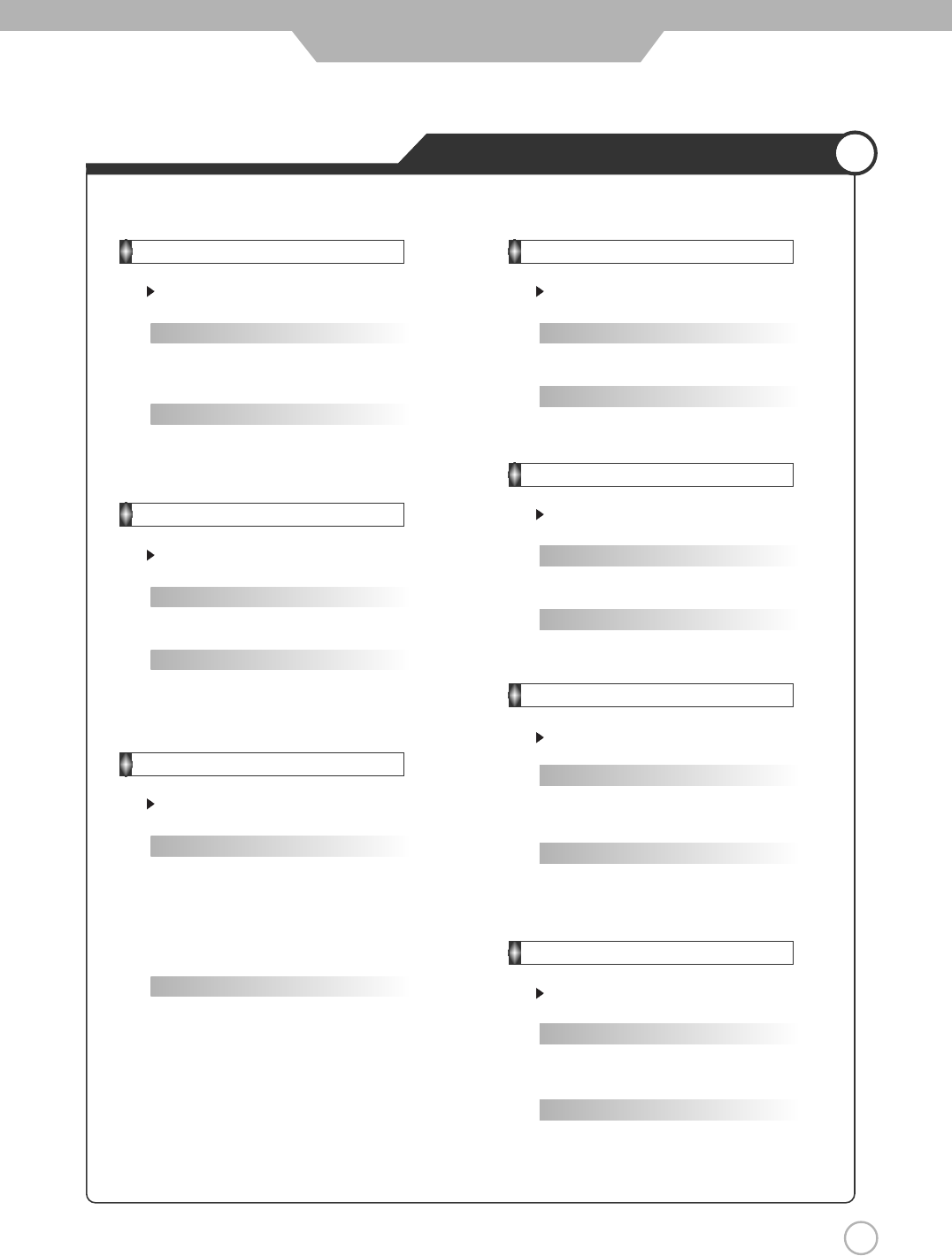
45
4. Volume Mute : w
To Select volume mute on/off
* Transmission
{w}{ }{SET ID}{ }{Data}{Cr}
Data 0 : On
Data 1 : Off
* Ack
{SET ID}{:}{OK}{x}{Data}{x}
Data 0 : On
Data 1 : Off
5. Volume Control : v
To adjust volume
* Transmission
{v}{ }{SET ID}{ }{Data}{Cr}
Data : Min : 00h~Max : 64h
* Ack
{SET ID}{:}{OK}{x}{Data}{x}
Data : Min : 00h~Max : 64h
6. Screen Mode : s
To Select Screen Mode
* Transmission
{s}{ }{SET ID}{ }{Data}{Cr}
Data 0 : Custom
Data 1 : Dynamic
Data 2 : Standard
Data 3 : Movie
Data 4 : Mild
* Ack
{SET ID}{:}{OK}{x}{Data}{x}
Data 0 : Custom
Data 1 : Dynamic
Data 2 : Standard
Data 3 : Movie
Data 4 : Mild
7. Brightness : b
To adjust Brightness
* Transmission
{b}{ }{SET ID}{ }{Data}{Cr}
Data : Min : 00h~Max : 64h
* Ack
{SET ID}{:}{OK}{x}{Data}{x}
Data : Min : 00h~Max : 64h
8. Contrast : k
To adjust Contrast
* Transmission
{k}{ }{SET ID}{ }{Data}{Cr}
Data : Min : 00h~Max : 64h
* Ack
{SET ID}{:}{OK}{x}{Data}{x}
Data : Min : 00h~Max : 64h
9. Information : f
Information on/off
* Transmission
{f}{ }{SET ID}{ }{Data}{Cr}
Data 0 : On
Data 1 : Off
* Ack
{SET ID}{:}{OK}{x}{Data}{x}
Data 0 : On
Data 1 : Off
10. Pip On : o
Pip on/off
* Transmission
{o}{ }{SET ID}{ }{Data}{Cr}
Data 0 : On
Data 1 : Off
* Ack
{SET ID}{:}{OK}{x}{Data}{x}
Data 0 : On
Data 1 : Off
External adjustment
RS232C Communication Protocol
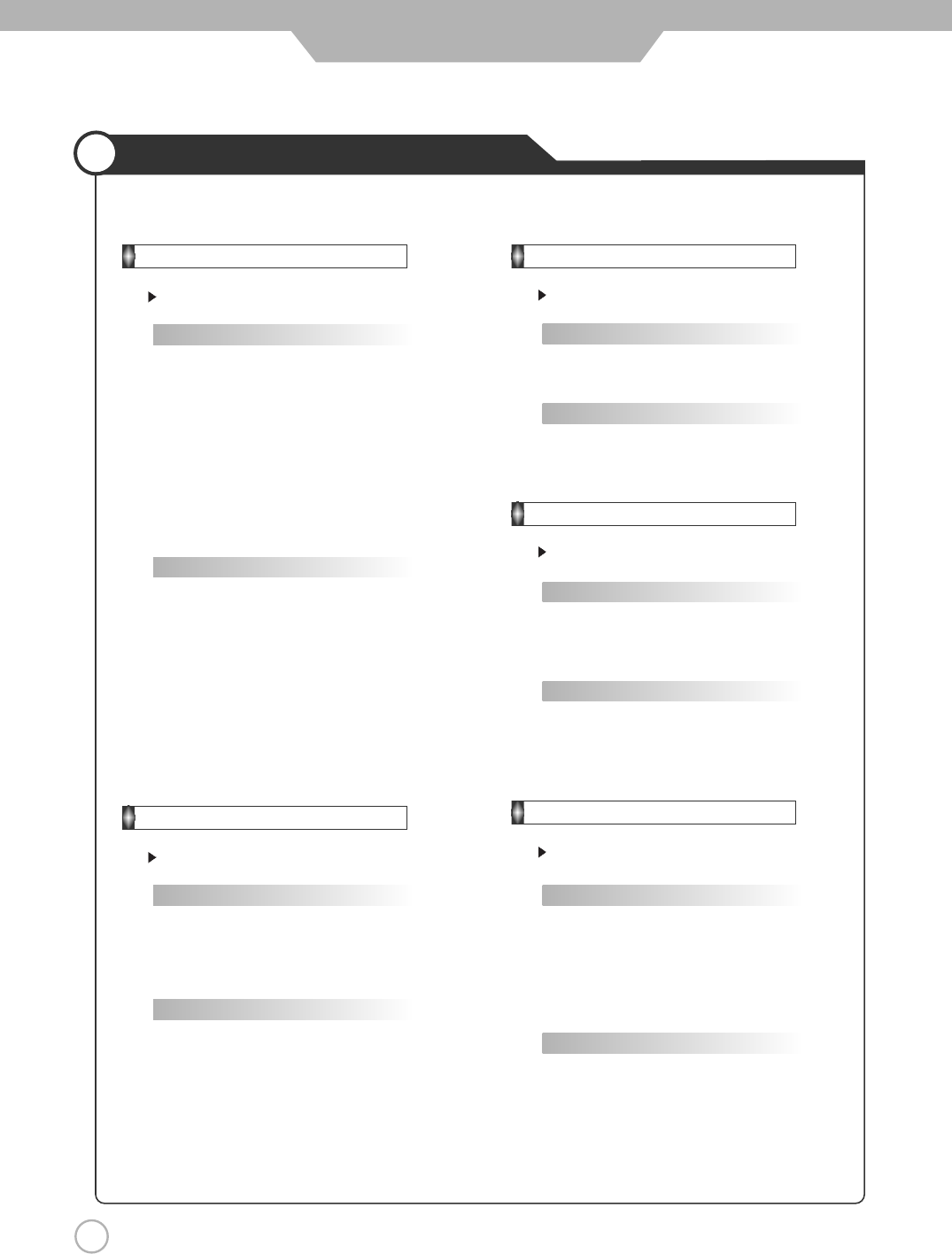
46
External adjustment
RS232C Communication Protocol
11. Pip Source : u
To Select Pip Source
* Transmission
{u}{ }{SET ID}{ }{Data}{Cr}
Data 0 : TV
Data 1 : Scart 1
Data 2 : Scart 2
Data 3 : Composite
Data 4 : S-Video
Data 5 : Component 1
Data 6 : Component 2
Data 7 : HDMI
Data 8 : PC
* Ack
{SET ID}{:}{OK}{x}{Data}{x}
Data 0 : TV
Data 1 : Scart 1
Data 2 : Scart 2
Data 3 : Composite
Data 4 : S-Video
Data 5 : Component 1
Data 6 : Component 2
Data 7 : HDMI
Data 8 : PC
12. Pip Location : n
To Select Pip Position
* Transmission
{n}{ }{SET ID}{ }{Data}{Cr}
Data 0 : Right Top
Data 1 : Left Top
Data 2 : Left Top
Data 3 : Right Bottom
* Ack
{SET ID}{:}{OK}{x}{Data}{x}
Data 0 : Right Top
Data 1 : Left Top
Data 2 : Left Top
Data 3 : Right Bottom
13. Pip Sound Set : e
To Select Pip Sound
* Transmission
{e}{ }{SET ID}{ }{Data}{Cr}
Data 0 : Main
Data 1 : Sub
* Ack
{SET ID}{:}{OK}{x}{Data}{x}
Data 0 : Main
Data 1 : Sub
14. Pip Mode : d
To Select Pip Mode
* Transmission
{d}{ }{SET ID}{ }{Data}{Cr}
Data 0 : Single
Data 1 : PIP
Data 2 : PBP
* Ack
{SET ID}{:}{OK}{x}{Data}{x}
Data 0 : Single
Data 1 : PIP
Data 2 : PBP
15. Sound Mode : y
To Select Sound Mode
* Transmission
{s}{ }{SET ID}{ }{Data}{Cr}
Data 0 : Custom
Data 1 : Standard
Data 2 : Movie
Data 3 : Music
Data 4 : Speech
* Ack
{SET ID}{:}{OK}{x}{Data}{x}
Data 0 : Custom
Data 1 : Standard
Data 2 : Movie
Data 3 : Music
Data 4 : Speech
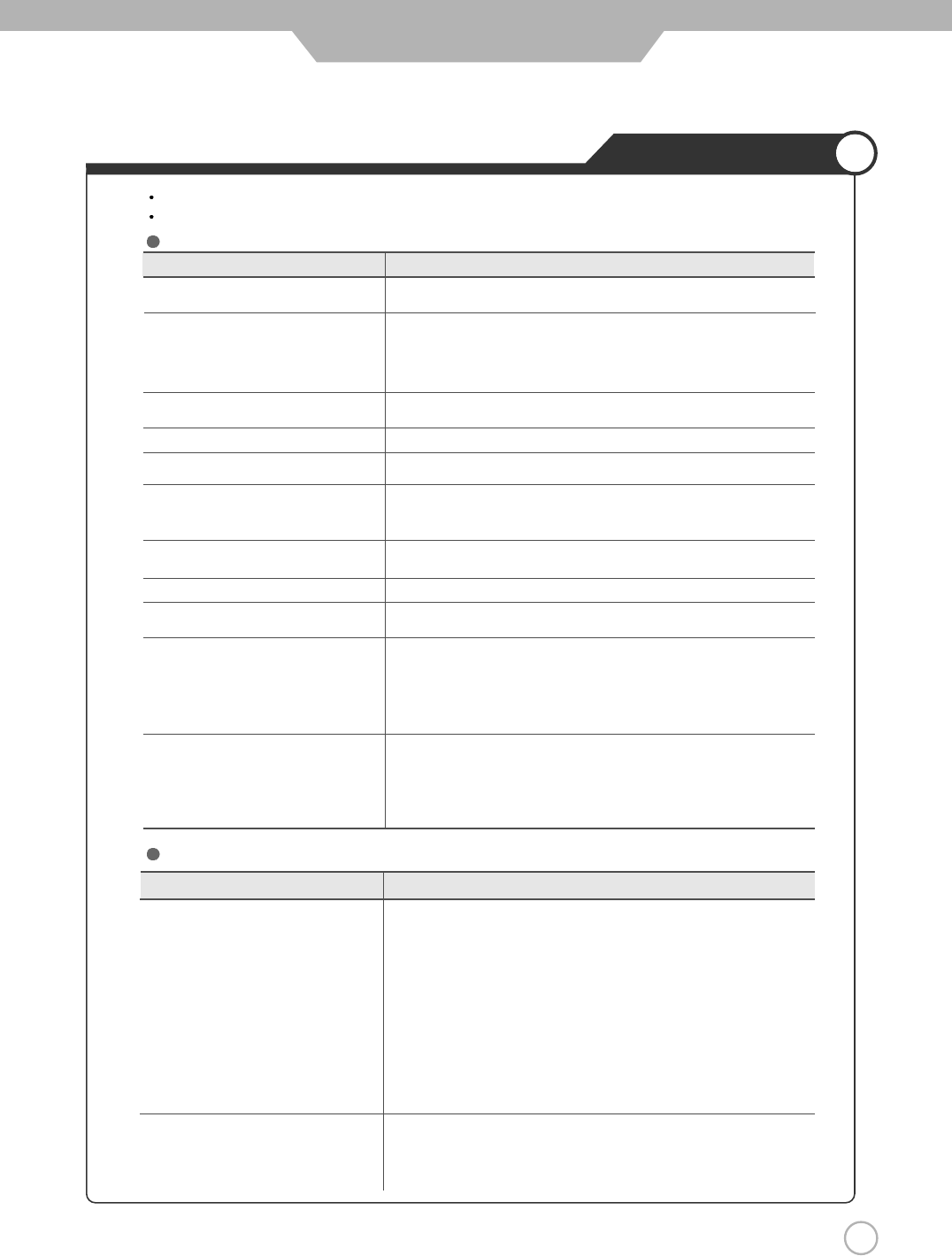
47
Maintenance and Service
Trouble shooting
Problem Action
Screen appears, Voice is not heard 1. Press the "Mute"button. (page 30)
2. Increase the sound by pressing volume adjustment button.
3. Check if voice terminal of external input is connected properly.
4. Check if speaker cables are connected properly.
5. If it is on PIP mode, convert audio of main screen and sub screen by
pressing SOUND SEL.
6. Select and check the other input.
If the sound still does not work and the other channels are the same after
you have done as the above, contact your dealer or an authorized
service center.
7. Check if the headphone jack gets pluged in.
8. Check if the speaker on/off selection at "On" in sound mode.
Lots of noise (static) occurs. When connecting a Set-Top-Box, check that it is on stereo broadcasting. If it
is, the TV program may not be available or the reception may be bad.
Check the audio source with another player. If that source is good, contact
your dealer or an Authorized service center.
Sound related Matters
In case a problem occurs with your
PDP Monitor
, please take the following steps first.
If you still have the problem, turn the power off and contact your dealer or an authorized service center.
Screen related Matters
Problem Action
The screen does not appear. Is the power plug pulled out? Insert the power plug. Turn the main
power button on and press the power button of the remote controller.
The screen appears too This problem occurs for a brief time in the process of
slowly after the power is turned on. image elimination processing in order to hide temporary screen noise
that occurs when the power is turned on. But if the screen does not
come after 1 minute has passed, contact your dealer or an
authorized service center.
Screen is too bright or too dark. Perform brightness adjustment or Contrast adjustment. (Please refer
to page 34)
Screen is too large or too small. Adjust the screen size. (Please refer to page 38)
Stripes appear on the screen Stop using wireless telephones, hair driers and electric drills.
and it shakes.
Simultaneous Screen Check that PDP Monitor and external equipment are connected.
does not appear. Check the inputs of simultaneous screen by pressing sub-screen
selection.
The screen does not move. Press the STILL button. (Please refer to page 42) Check if the Pause
button is pressed on external equipment.
Computer Input Screen is abnormal. Perform manual fine adjustment (Please refer to page 50).
Automatic Turn On does not work. Automatic Turn On function works only when turning the PDP
Monitor off with the remote controller or Standby button.
The screen shows snow or black patt-
erns and then reverts to a clear picture.
The problem only occurs with DVI input when an abnormal signal is
issued during an authorization process for a High-bandwidth Digital
Content Protection (HDCP) compatible device. While it may vary
depending on the actual device, the screen reverts to normal within a
short time (5-7 seconds).
The screen flickers in multi-screen
mode (PIP/PBP).
The problem occurs when both main and sub screens are supplied with
interlaced signals. Whilst an internal de-interlacer should remove any
trembling that occurs with interlaced signal input, either of the screens
can still tremble when both screens are input with interlaced signals,
because there is only one de-interlacer available.
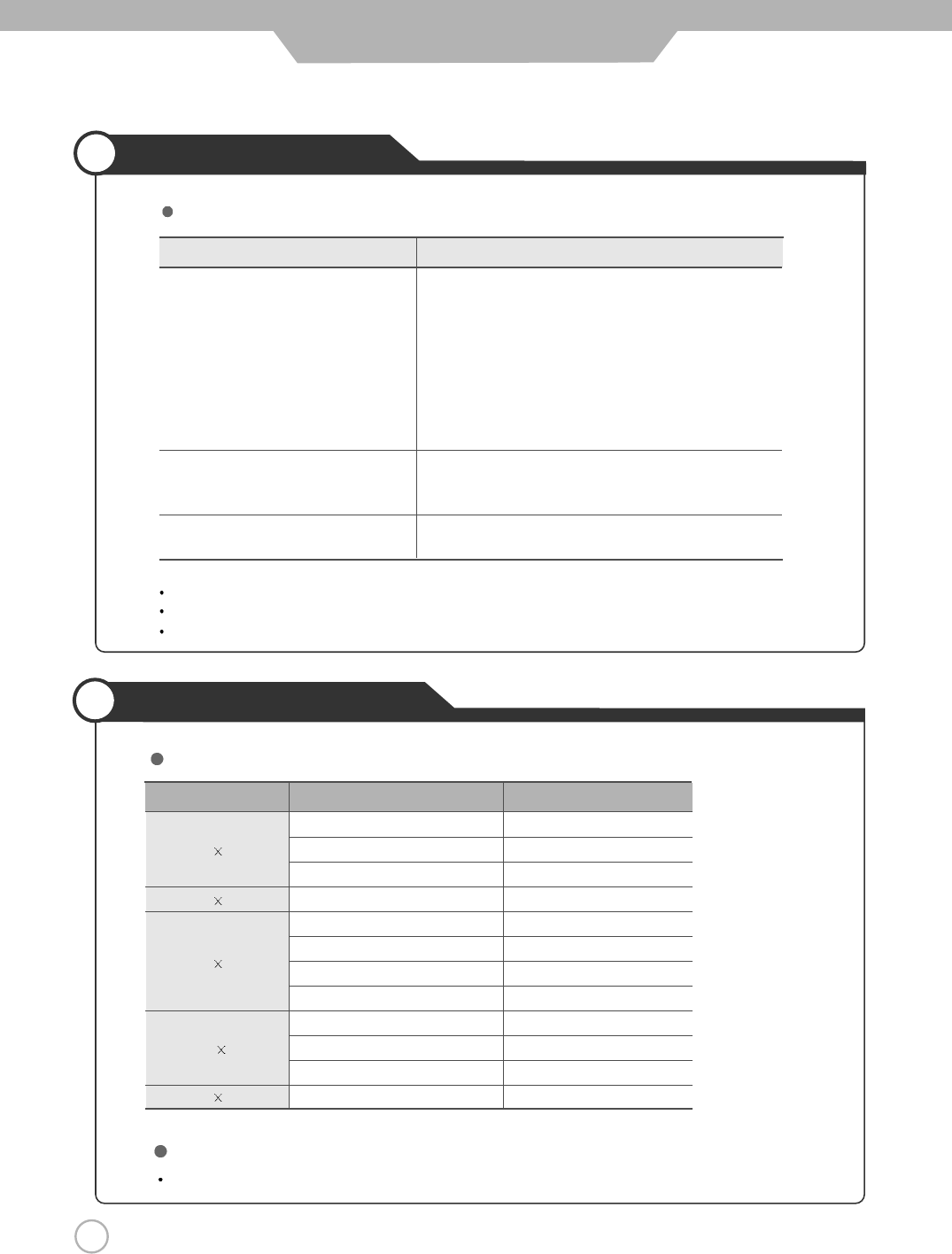
48
Maintenance and Service
Trouble shooting Tips
Supported Display Modes
Problem Action
Remote controller does not work. 1. Check if main power is On.
2. Check that the batteries of the remote controller were
loaded properly.
3. Check to see if any obstacle exists between the PDP
Monitor and the remote controller and remove it, if any.
4. If the batteries have no power, replace them with two
new batteries.
5.Please check out current mode of fnuction key.
PDP Monitor makes strange noise. It is the noise when the mechanism expands or contracts
from to changes to the environment due to factors such
as humidity, temperature, etc. It is not a failure.
PDP Monitor indication lamp is On. The red means the Stand-by power is ON. It will take a
few seconds to turn off as the main power is off.
This PDP Monitor is for household use and registered as suitable on electromagnetic waves.
Therefore, you can use it in every location as well as residential areas.
For improvement of product's quality, program can be upgrade without costomer's agreemant.
Others
If any signal of unsupported resolution is input, the "Out of Range" message appears.
Considerations in Installation
PC mode
Resolution Horizontal Frequency (KHz) Vertical Frequency (Hz)
31.47 60
37.86 72
37.50 75
31.47 70
35.15 56
37.88 60
48.88 72
46.88 75
48.36 60
56.48 70
60.02 75
64.0 60
640 480
720 400
800 600
1024 768
1280 1024
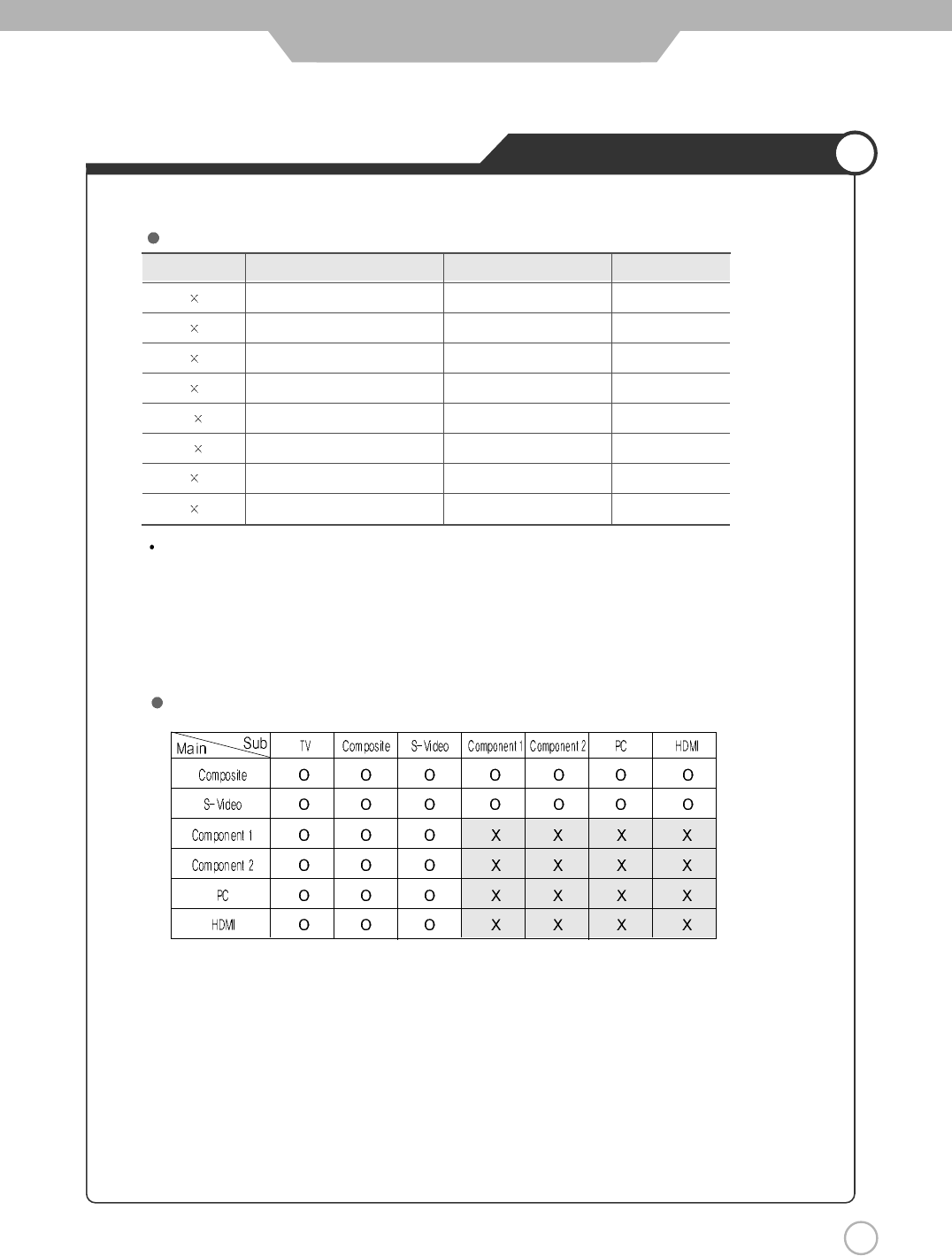
49
Maintenance and Service
Supported Display Modes
If any signal of unsupported resolution is input, the "Out of Range" message appears.
Component Mode
[
Y
,
C
b(
P
b), Cr(Pr)]
Resolution Horizontal Frequency (KHz) Vertical Frequency (Hz)
720 480 15.73 60.00 SDTV, DVD 480i
720 576 15.63 50.00 SDTV, DVD 576i
720 480 31.47 59.94 SDTV, 480p
720 576 31.25 50.00 HDTV, 576p
1280 720 37.50 50.00 HDTV, 720p
1280 720 45.00 60.00 HDTV, 720p
1920 1080 28.12 50.00 HDTV, 1080i
1920 1080 33.75 60.00 HDTV, 1080i
PIP Matrix Table
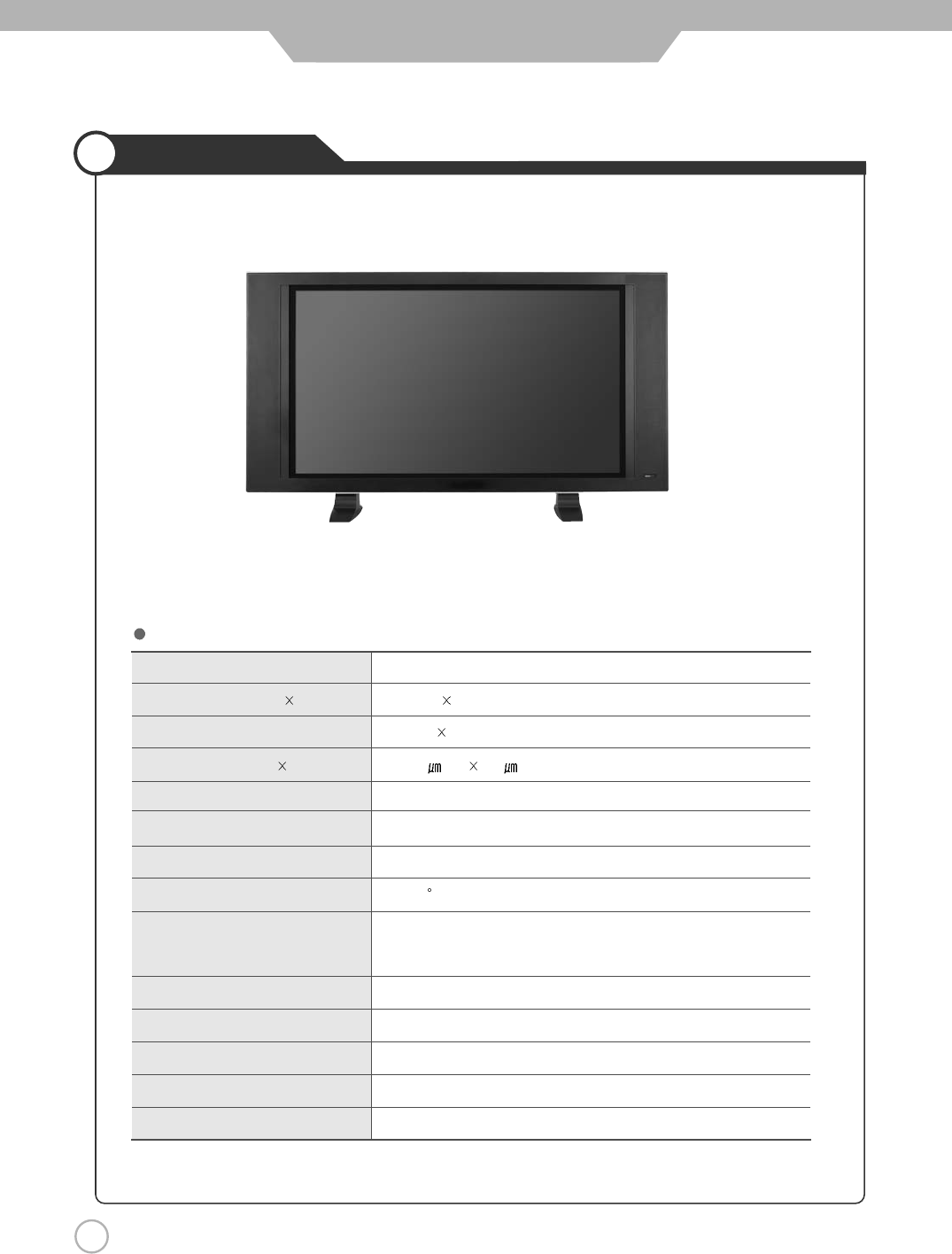
50
Maintenance and Service
Specifications
Aspect Ratio 16 : 9
Screen Size (H V) 921.6 519.2mm
Resolution 1024 768( XGA ) (1 Pixel = 3RGB Cells)
Cell pitch (H V) 300 (H) 676 (v)
Displayable Colors 16.7M
Brightness 1200cd/m2(w/o filter)
Contrast 10,000:1 (MAX)
Viewing Angle 160
Input signal NTSC
SD, HD, VGA~SXGA
Tuner NONE
PC Input Analog RGB, HDMI
AC Input AC100-240V~, 50/60Hz, 4A(MAX)
Power Consumption 320W (MAX)
Standby Mode 1W
42" Specification

51
51
DIGITAL ART
90-X-42-X3NM-BDMI-00